Deep down in Dorchester County, there’s a secret place…
Chesapeake Lens: “Dragon’s Lair” By John Maloney
The Spy Newspapers may periodically employ the assistance of artificial intelligence (AI) to enhance the clarity and accuracy of our content.
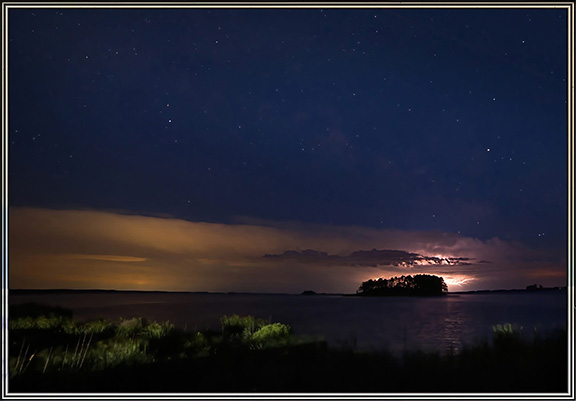
Nonpartisan and Education-based News for Chestertown
The Spy Newspapers may periodically employ the assistance of artificial intelligence (AI) to enhance the clarity and accuracy of our content.
Italian artist Giuseppe De Nettis (1846-1884) was born into a wealthy family in Barletta, Italy. He trained for a short time in the Italian classical style of painting. At the age of 21, he moved to Paris, the heart of the art world at the time. He was engaged by Adolphe Goupil, founder of Goupil & Cie (1850), the leading art dealer and publisher in Paris in the 19th Century, to create saleable genre paintings. His works were exhibited in the Salons, and he received a Gold Medal and was made a member of the Legion of Honor. He became a success and his work was in demand.
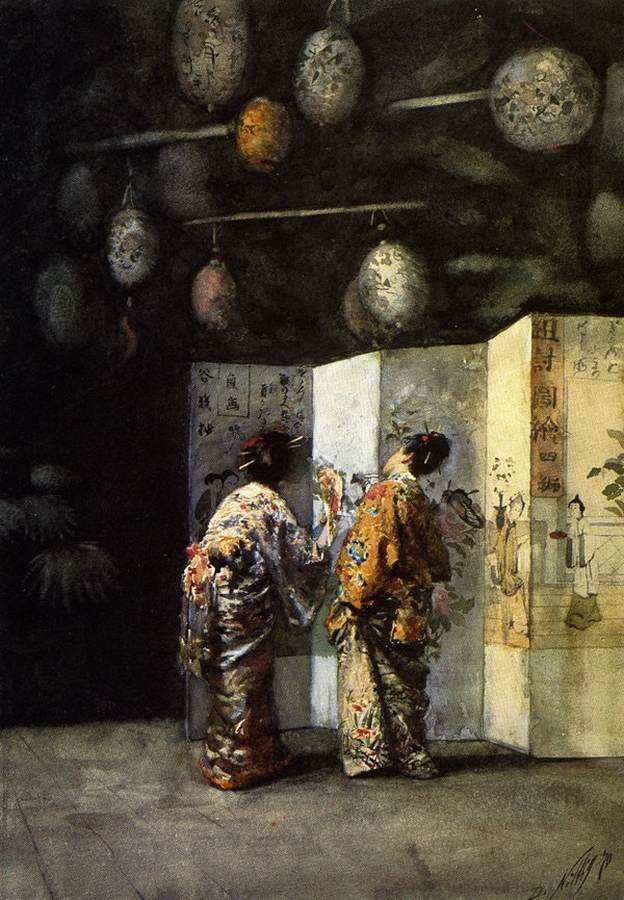
“Japanese Ladies Admiring a Screen” (1870)
“Japanese Ladies Admiring a Screen” (1870) (watercolor and pencil) (14’’x11’’) responded to the interest in Japanese ukiyo-e prints that were introduced to France in the 1860s. The prints were among De Nettis’s early purchases of art. The patterns of Japanese silk kimono fabrics and the lanterns and screens fascinated French patrons and artists alike. Van Gogh amassed one of the largest collections of ukiyo-e prints. The classical style of painting that De Nettis learned is obvious in his use of traditional techniques of color and light. The composition is pleasing, and a prospective buyer would have enjoyed the lavish kimonos and the patterns on the lanterns and folding screens. The small scale would have appealed to buyers with moderate funds and normal size houses.
In 1869, De Nettis married Leontine Lucille Gruvelle (1842-1913), an accomplished and beautiful woman, who often served as his model. De Nettis fled Paris for London in 1870 to avoid the Franco-Prussian War and the siege of Paris from September 1870 until January 1871. Monet, Pissarro, and Sisley were among the artists who went to London, and Degas visited his family in New Orleans. On his return to Paris, De Nettis stopped in Italy and was the first artist to depict the eruption of the Mt Vesuvius volcano.
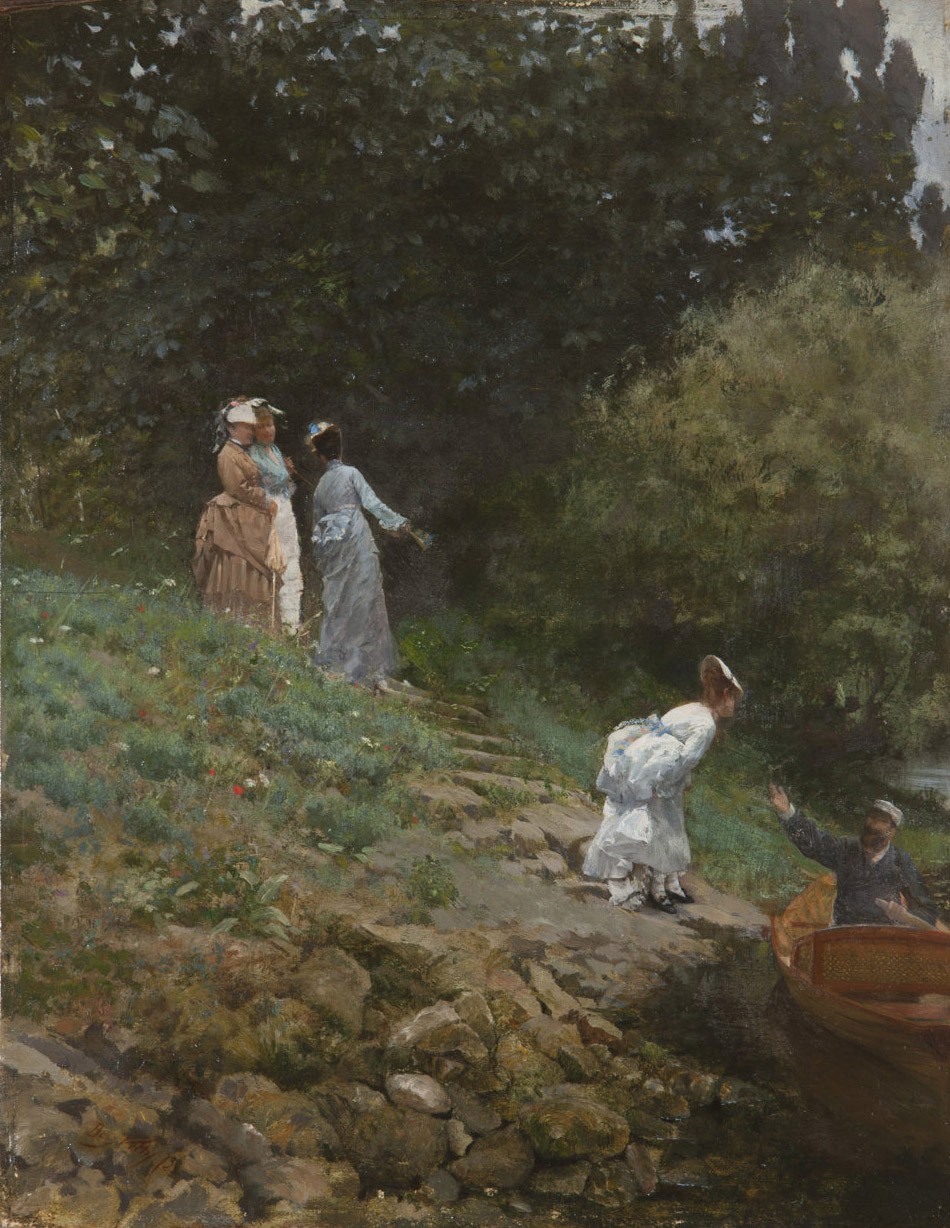
”La Grenouillere”
When De Nettis returned to Paris in 1872, he began painting cityscapes and the people of Paris. La Grenouillere was a floating restaurant on the Seine at Croissy-sur-Seine. It was a popular gathering place for Monet, Renoir, and other Impressionists. “La Grenouillere” (1873-74) (14”x11”) is a depiction of four fashionably dressed women, walking down a stone stairway to engage a boatman to row them across to the restaurant. The day is sunny and the flowers are popping out on the hill. The women perhaps anticipate a pleasant boat ride.
Having met several of the Impressionists, De Nettis began exploring some of their techniques: painting outdoors, exploring suggestive brushstrokes, and using the colors of sunlight to create shadows. For example, the shadows on the white dress of the woman engaged with the boatman are painted blue, not gray.
Degas invited De Nettis to show his work in the first Impressionist Exhibition in 1874. His five paintings, not well liked by some of the Impressionists, were hung in a dark spot. He did not show with them again. His work continued to combine elements of both Realism and Impressionism. De Nettis’s Paris home became a popular salon for artists, poets, writers, musicians and others, including Oscar Wilde, Alexander Dumas, and Emile Zola. De Nettis often cooked “lasagne alla Barlettana,” an Italian dish that received cheers from the guests, “Viva De Nettis.”

“Le Place du Pyramids” (1875)
De Nettis also chose to paint images of the reconstruction of famous landmarks that were damaged during the Franco-Prussian War. “Le Place du Pyramids” (1875) (36”x30”) is a depiction of an iconic Parisian location. It was named in honor of Napoleon’s victory in Egypt in 1789. The statue of Joan of Arc is prominent at the center. Advertisements cover the scaffolding around the building. Parisiens going about their daily business walk through the busy square, passing by market carts, carriages, and a horse drawn bus. The sky is gray and the pavement wet. Le Place du Pyramids is in the middle of Rue de Rivoli, near the eastern end of the Tuileries Gardens.
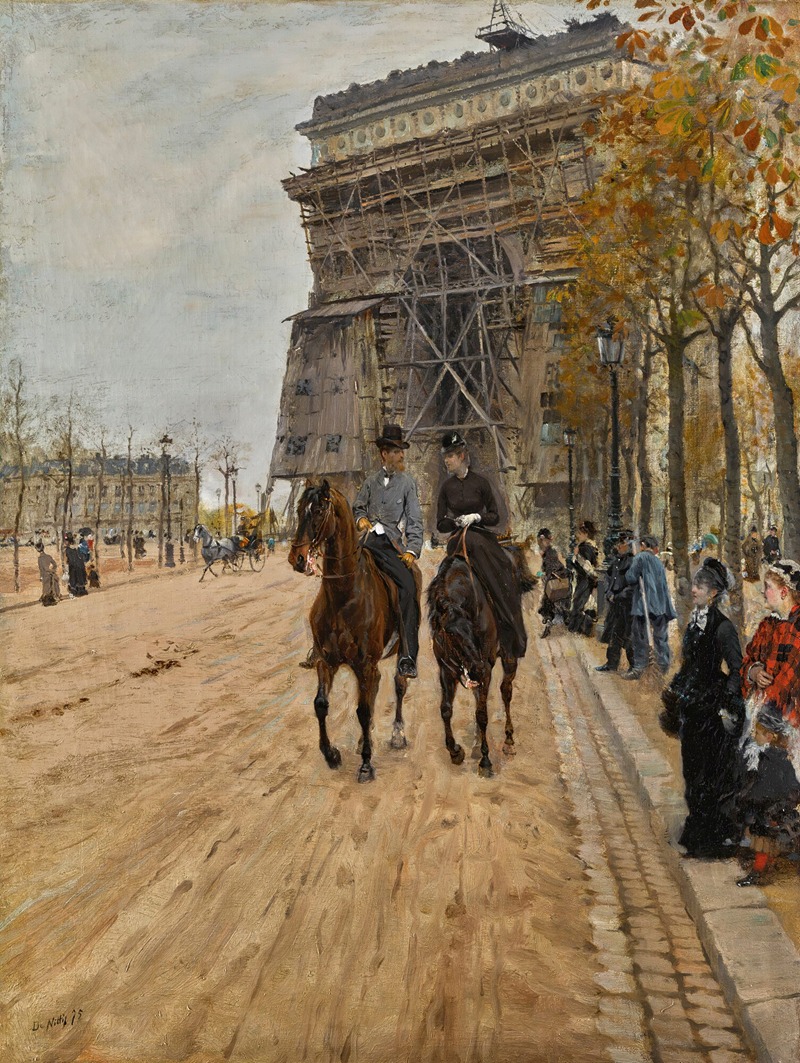
“Arc de Triomphe” (1875)
“Arc de Triomphe” (1875) (21”x16’’) is a depiction of another well-known Paris landmark, under scaffolding for repair of damage during the Franco-Prussian War. The painting represents the resilience of the Parisiennes. It is autumn, and the tree leaves have turned orange. A wealthy couple on horseback enjoy a ride along the Champs-Elysees. They have passed under the Arc de Triomphe. De Nettis was adept at painting horses, and like Degas, he often painted the races at Longchamp. People are about to cross the road, among them a red-haired woman in a bright plaid coat, a well-dressed woman in black, and a young girl wearing red socks. The trio is probably an upper-class mother, her daughter, and a maid or nanny.
The figures are painted realistically. The avenue is created with casual brushstrokes of a variety of beiges and browns, but also blues. Across the Champs-Elysees, the horse drawn carriage, people, trees, and distant buildings are more Impressionistic. De Nettis’s use of black paint throughout the painting distinguishes him from the Impressionists.
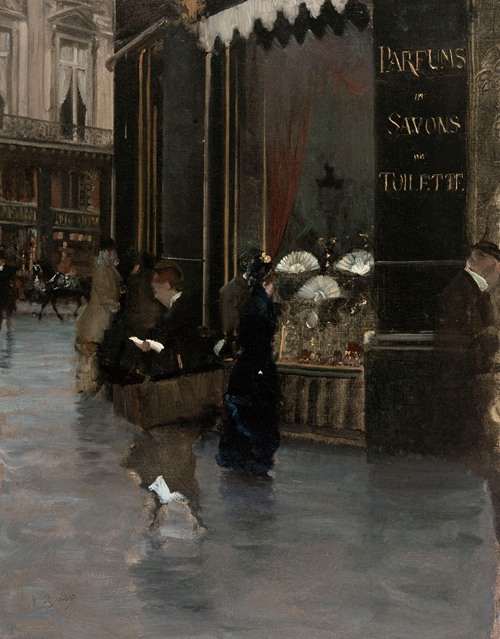
“La parfumerie Violet, on the Boulevard des Capucines” (1880)
“La parfumerie Violet, on the Boulevard des Capucines” (1880) is a depiction of what was one of the most elegant boulevards in Paris. The Maison Violet was opened in 1827 by Francois-Etienne Violet. Famous for its fragrances, its perfumes received a great many awards and patents for their scents. The studio of the famous French photographer Felix Nadar (1820-1910) was located at 35 Boulevard des Capucines. The rich and famous came there to have their photographs taken. The studio also was the location of the first Impressionist exhibition in 1874.

“Breakfast in the Garden” (1884)
“Breakfast in the Garden” (1884) (34”x46’’) is one of De Nettis’s last works. His beloved wife Leontine and their son Jacques sit at a table in the shade of overhanging trees, and they enjoy breakfast in the sunny garden. The table is set with coffee cups, silverware, a China cream and sugar set, a vase of spring flowers, and a white tablecloth with napkins. In front of the table is an empty wicker chair where De Nettis had sat. Leontine and Jacques concentrate on a curious duck that has come close. Other ducks are on the lawn and under the shade of nearby trees. De Nettis painted a happy time with his family. His skill at painting in the Impressionist style, when he wanted to, is fully visible.
During his short career, De Nettis painted in Paris, on yearly trips to London, and while visiting Italy. He was named Knight of the Order of the Crown of Italy in 1875.
De Nettis died in 1884 at the young age of 38 from a stroke. He was honored in 1886 with a memorial exhibition at The Galerie Bernheim Jeune in Paris. Other exhibitions followed. In1984, he was honored with a 300 lire postage stamp. Since De Nettis chose to go his own way at a time when the popularity of Impressionism was on the rise, his works became eclipsed for a time. Today, his work is considered among the best of his time.
Beverly Hall Smith was a professor of art history for 40 years. Since retiring to Chestertown with her husband Kurt in 2014, she has taught art history classes at WC-ALL and the Institute of Adult Learning, Centreville. An artist, she sometimes exhibits work at River Arts. She also paints sets for the Garfield Theater in Chestertown.
The Spy Newspapers may periodically employ the assistance of artificial intelligence (AI) to enhance the clarity and accuracy of our content.
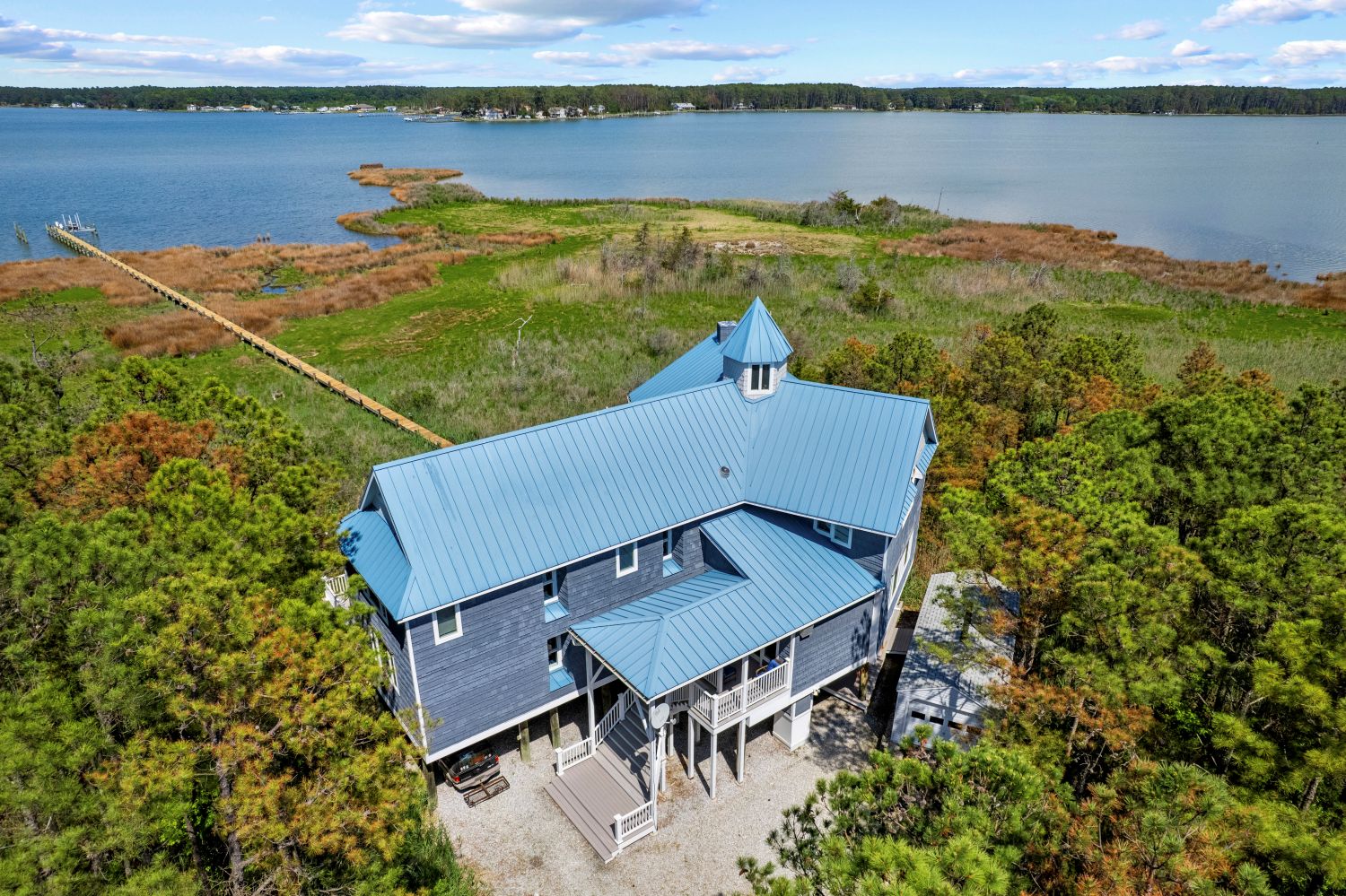
Modern geometric design harmonizes with pristine waterside surroundings.
It’s not often that I find a contemporary house to feature, so I when I went online and saw this unique contemporary house near Cambridge, I immediately contacted the listing agent to arrange a visit. On the day of my tour, I drove along the gravel entry drive between walls of tall phragmites and towering Loblolly pines to discover this contemporary waterfront estate on 11.88 private acres with 1,500 feet of shoreline along serene Brooks Creek.
Built in 2007, the “Y” shaped house has a coastal layout with a compact footprint for minimal disturbance of the site. Its geometric “Y” shape reaches out to maximize water views and its turret peeks through the blue metal roof at the intersection of the three wings of the house for bird’s eye views of the surrounding landscape and water.
Since the temperature on the day of my visit was in the mid 90’s, I was very grateful to park my car at the ground level under the shade of the second floor. In addition to parking, there is a deck and a low ramp to a one-car garage next to the house. Two sets of stairs lead up to the second floor; at the front of the house, one set goes up to the main entry’s covered porch with its blue metal roof.
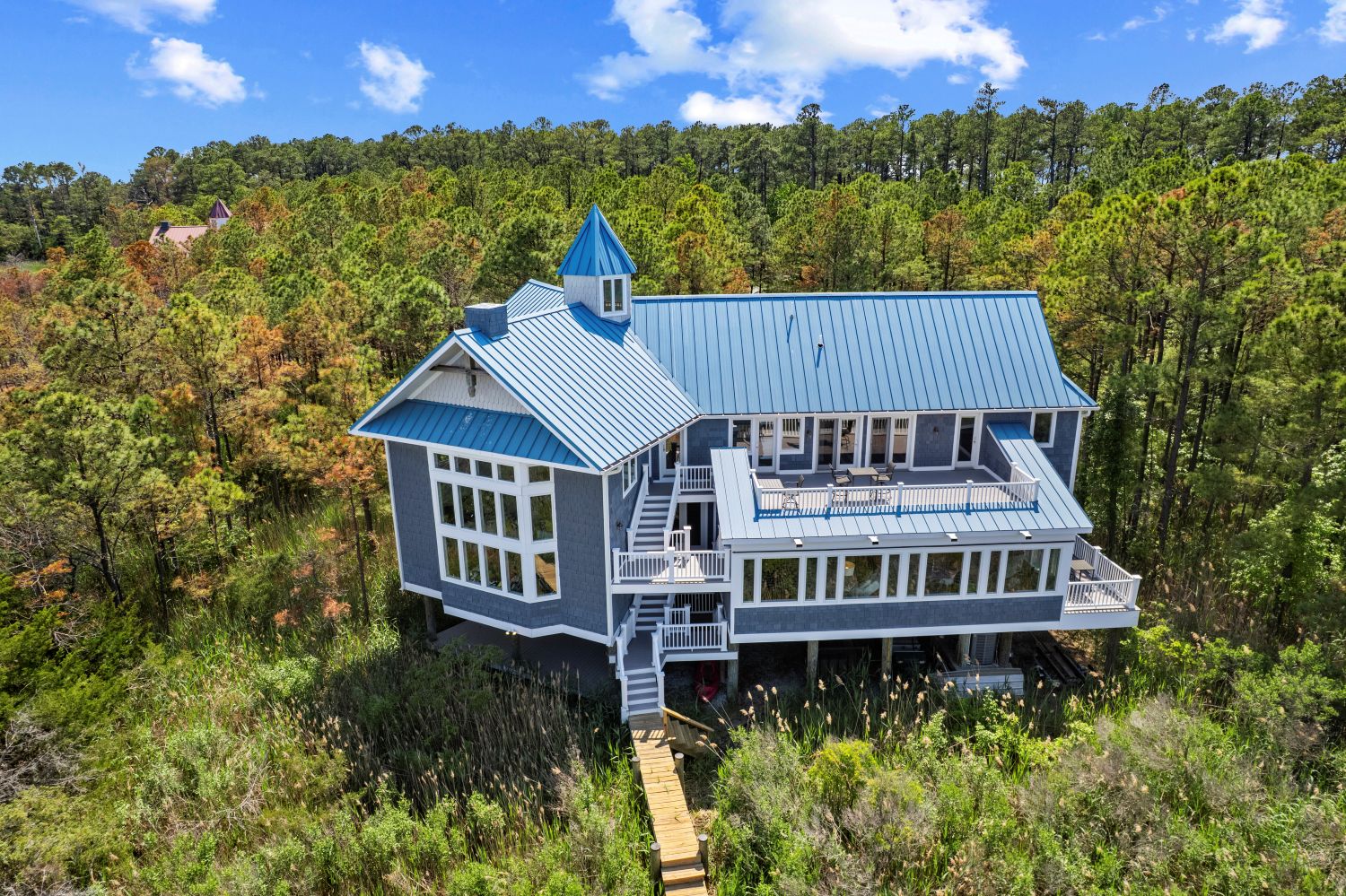
Elevated structure connects effortlessly with expansive shoreline views.
At the rear of the house, a half flight of steps leads from the parking level to the landing of the second set of stairs for access to both the long elevated walkway to the pier and also to the third floor deck. The house floats above the site and the multiple windows from the two-story bay wall projection, the wrap-around windows at the second floor and the windows and doors at the third floor offer unobstructed panoramic views of Brooks Creek. I walked to the end of the long pier and turned back to admire the massing of the house with its blue and white color scheme that stands out against its green surroundings.
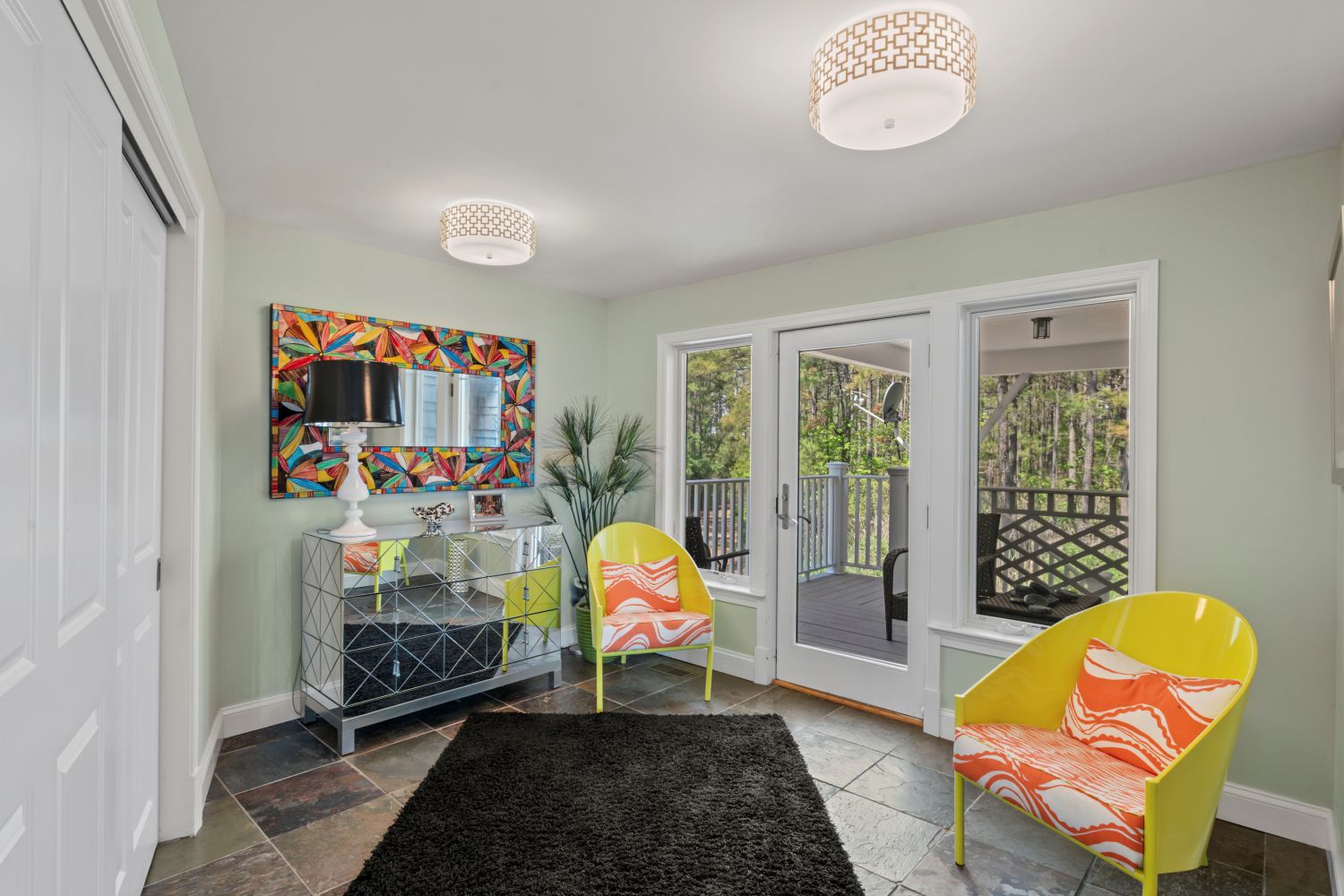
Flagstone flooring and vivid accents warmly transition to sleek interiors.
The large front porch furnished with a group of rattan seating leads to the foyer with flagstone flooring and neutral wall color. The splashes of color in the bright yellow chairs, red and white cushions and the multicolored mirror frame introduce the contemporary interior design. As I walked through the foyer, the vista opened up to the reveal the open plan dining room-living room.
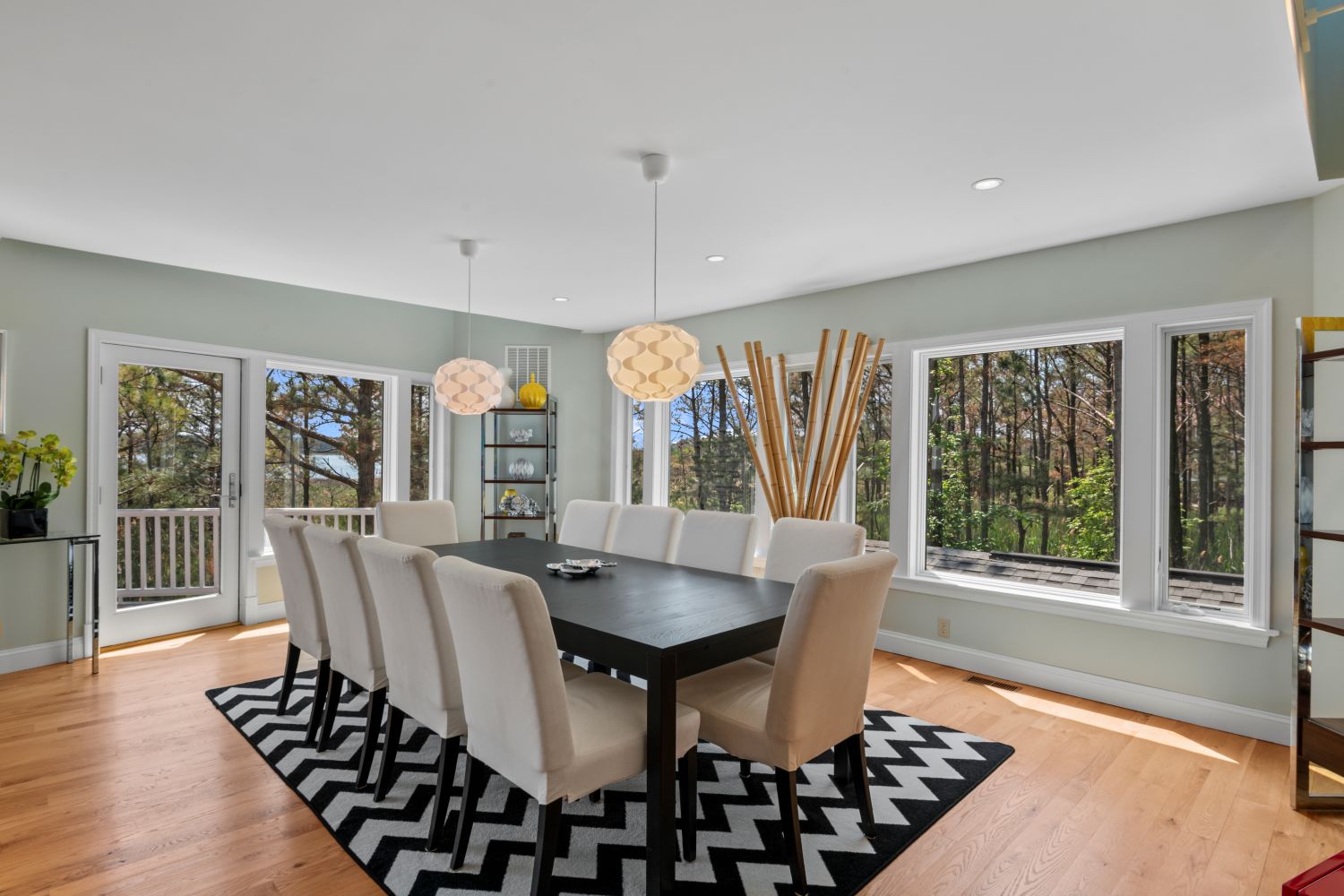
Contemporary lines and bold textures invite seamless entertaining.
The spacious dining room accommodates the long black table with its sleek lines and ten chairs, anchored by the rug with its kinetic black and white design. The beautiful wood floors flow into the living room and family room. The side wall of two pairs of wide picture plane windows with operable units open up the space to the landscape. The other wall with a glass door, picture plane window and another operable unit leads to the adjacent deck for water views. The deck is the perfect spot to set up one’s grille for summer entertaining.
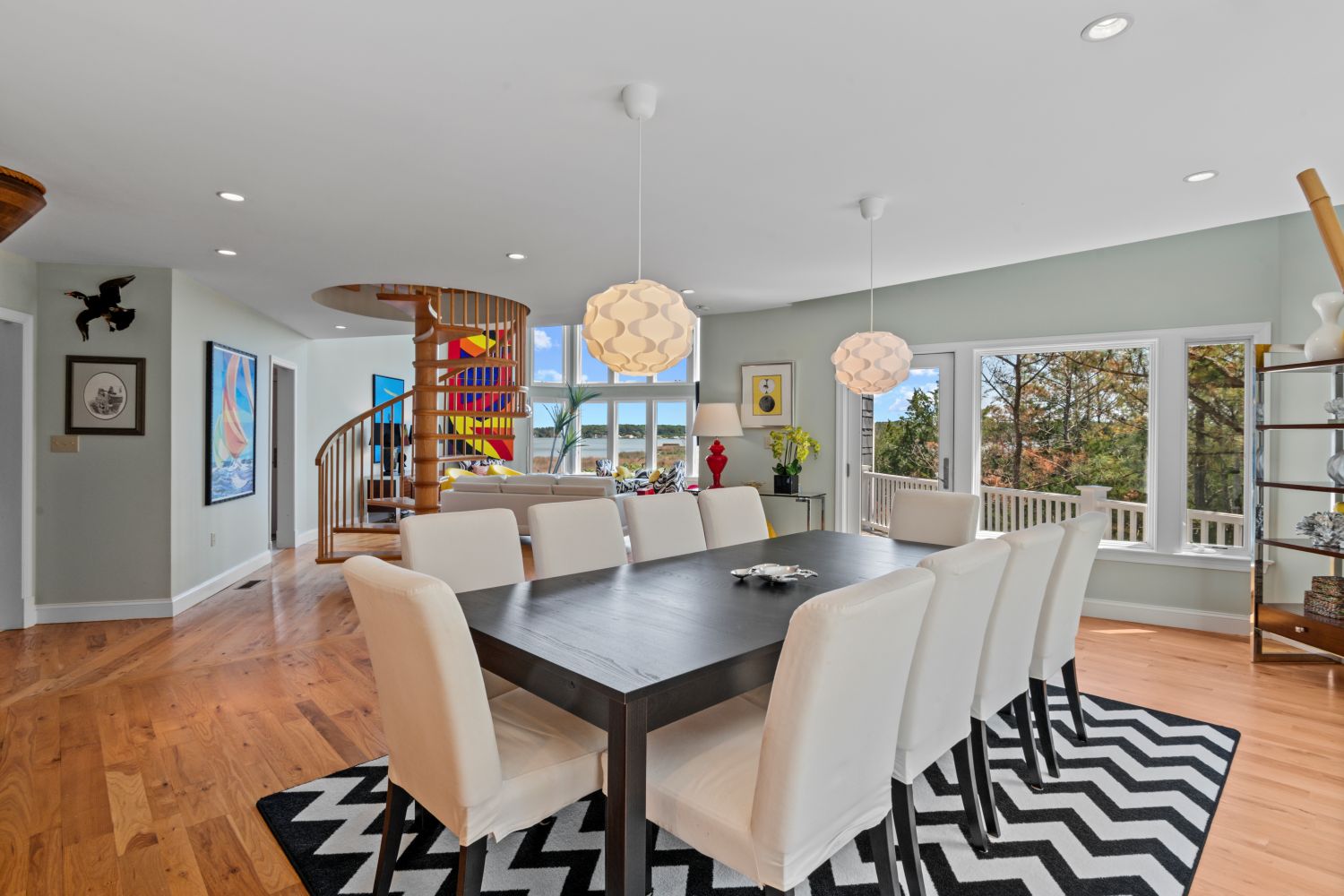
The oak spiral stair serves as a sculptural anchor amidst open vistas.
From the dining room, the focal point is the solid oak circular stair that connects the second and third floors. The stairs then penetrate the second floor ceiling to the turret above with windows on two walls for fantastic bird’s eye views of the landscape and Brooks Creek. From the table, the angled vista through the living room’s bay wall projection infilled with windows offers views of Brooks Creek.

Two-story bay windows frame endless landscapes and shimmering waters.
The living room’s two-story high bay wall of windows offers long views of the landscape and water and I imagine a starry night filled with stars is even more spectacular. The high windows at the side wall bring in additional light to keep this room sunny all day. I loved the colorful art accents, especially the abstract panels on the angled wall that reminded me of Frank Stella’s work.
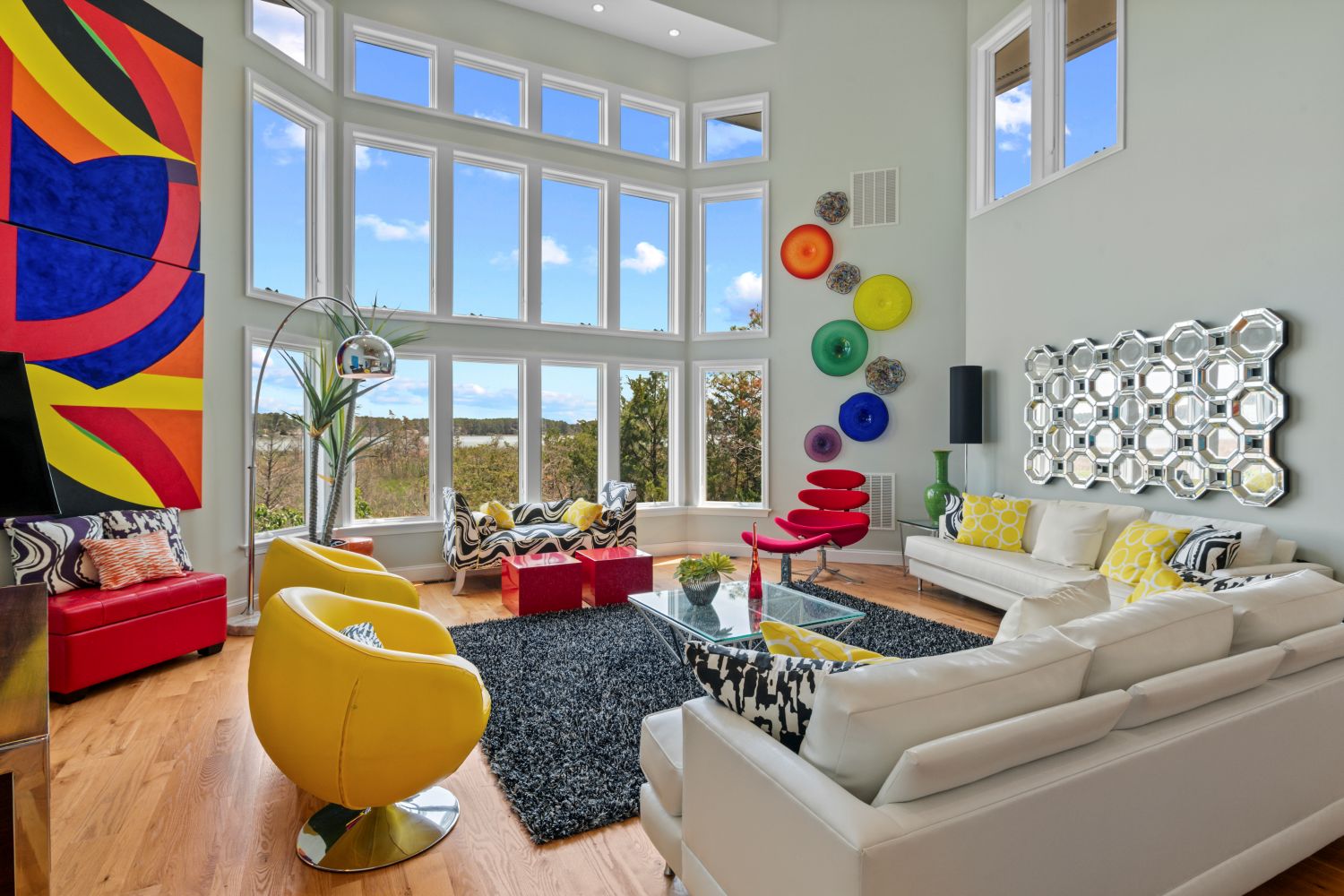
Sunlit accents and bold artwork create a cozy respite by the window. The home’s soft gray walls and neutral floors provide an opportunity for personalization throughout.
At the other side wall, another pair of high windows continues the sun’s daily path across the room. The mix of the two full length sofas’ neutral upholstery with accents of bright primary colors creates a fun space for relaxing with family and friends. I especially liked how the bench in front of the window wall is strategically placed for the family pet to doze in the warmth of the sun.
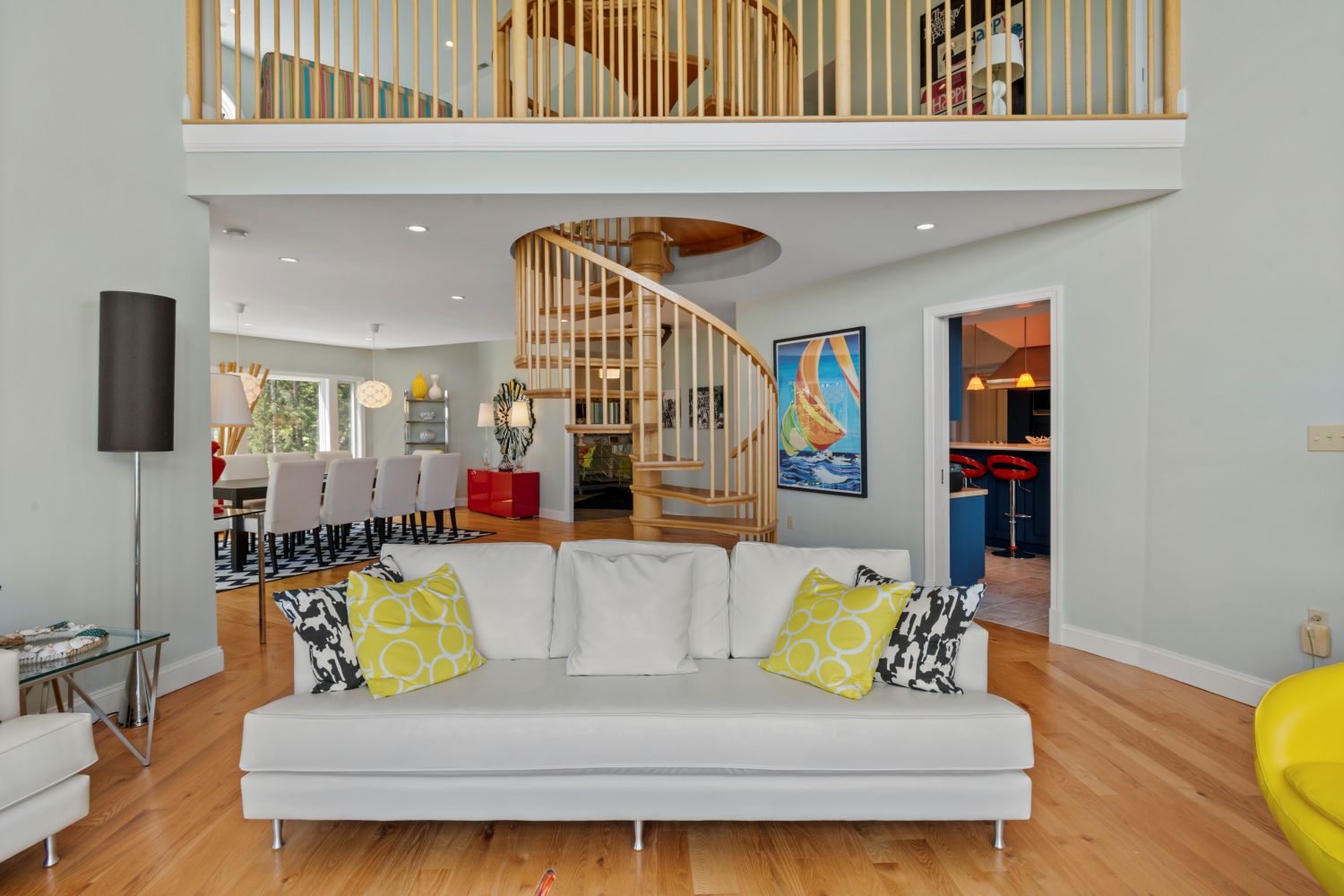
Sweeping angles and textured finishes unite functional spaces beautifully.
The overlook at the third floor above the sofa define the edge of the Living Room. The oak circular stair becomes a sculptural element and I admired how the railing at the overlook matches the spindles of the stair. The sweeping, angled vista from the living room to the dining room, foyer and kitchen gives depth to the spatial volume.
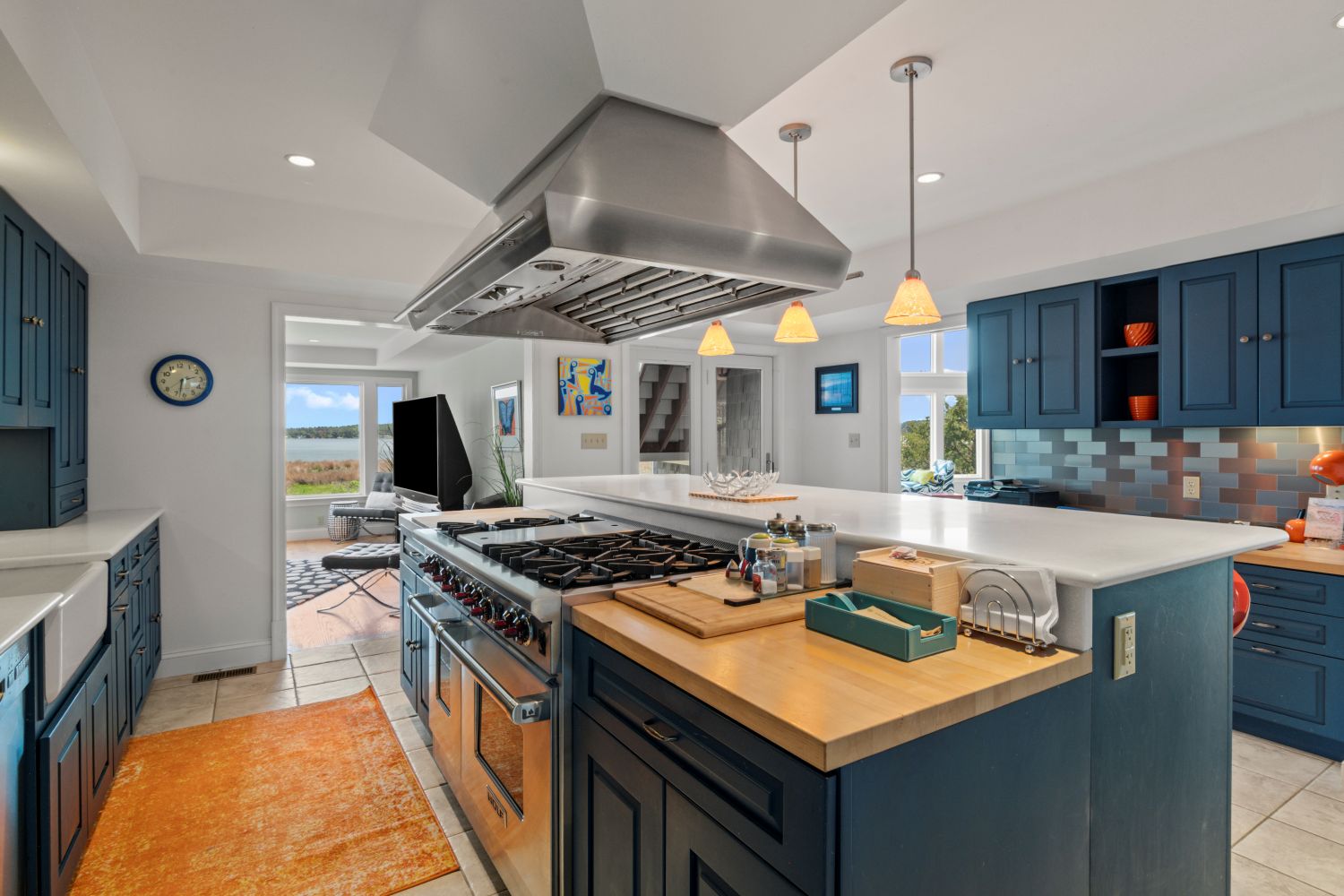
Elegant details shine in the gourmet kitchen, which boasts rich blues and panoramic water views.
The blue theme of the exterior siding and roof continues into the gourmet kitchen whose top tier appliances including a Subzero Wolf R/F would please any chef. The ceiling is detailed with a soffit above the upper cabinets for ambient lighting and the stainless steel hood for the Wolf stove is connected to the upper ceiling by sloped planes of drywall. The marble countertops stand out against the deep blue cabinets and the backsplash’s interlocking two-toned colors adds a playful touch. The wide wall opening between the kitchen and the adjacent family room gives the cook a water view. Behind the kitchen is a hall that leads past the laundry closet to the primary ensuite.
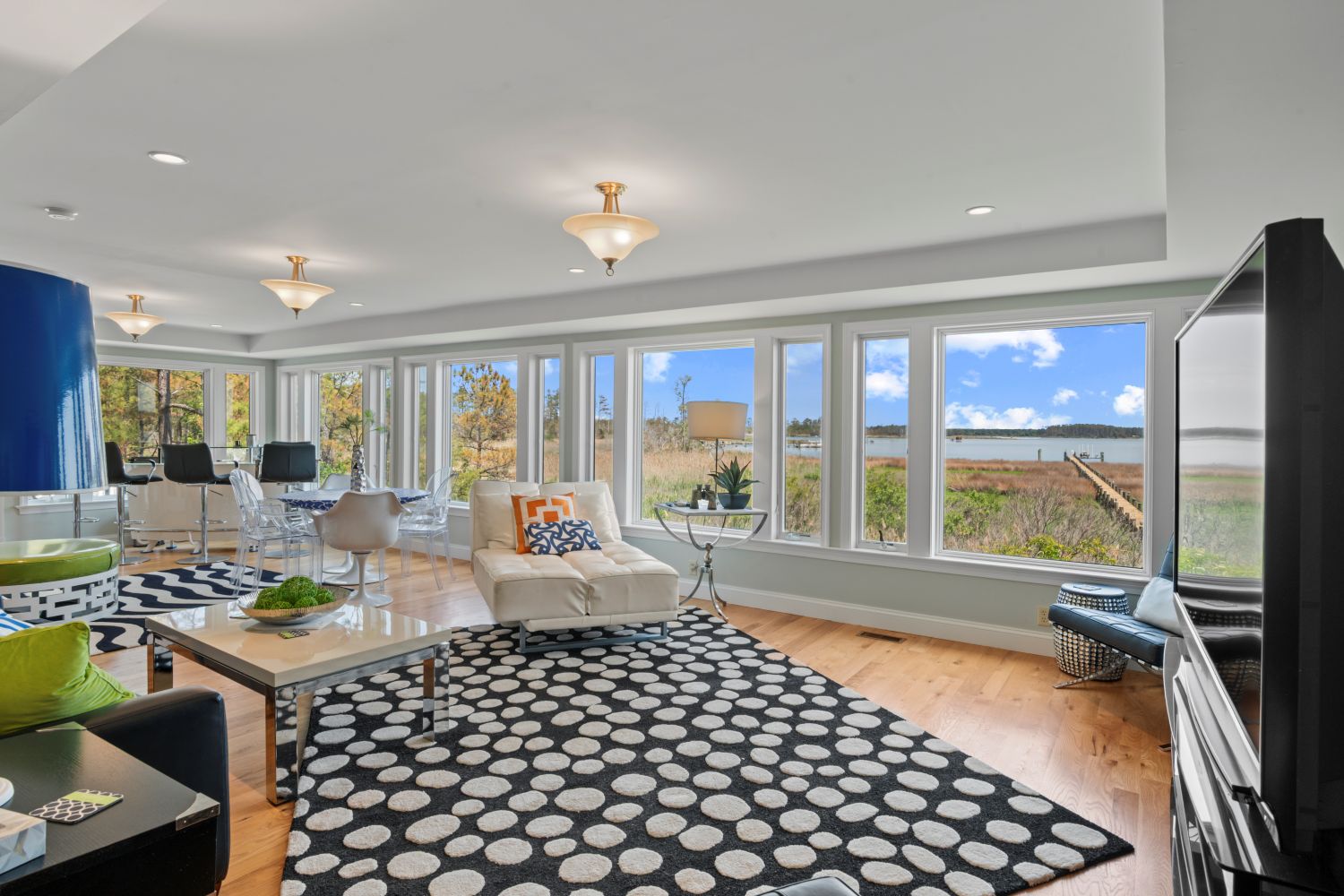
Wrap-around windows immerse guests in tranquil Brooks Creek scenery.
The family room extends across the length of the long leg of the “Y” floor plan. Like the dining room, the mix of the windows’ tall picture planes and operable units wrap around the corner of the room to the side deck to offer panoramic views of the serene landscape to Brooks Creek and the opposite shoreline.
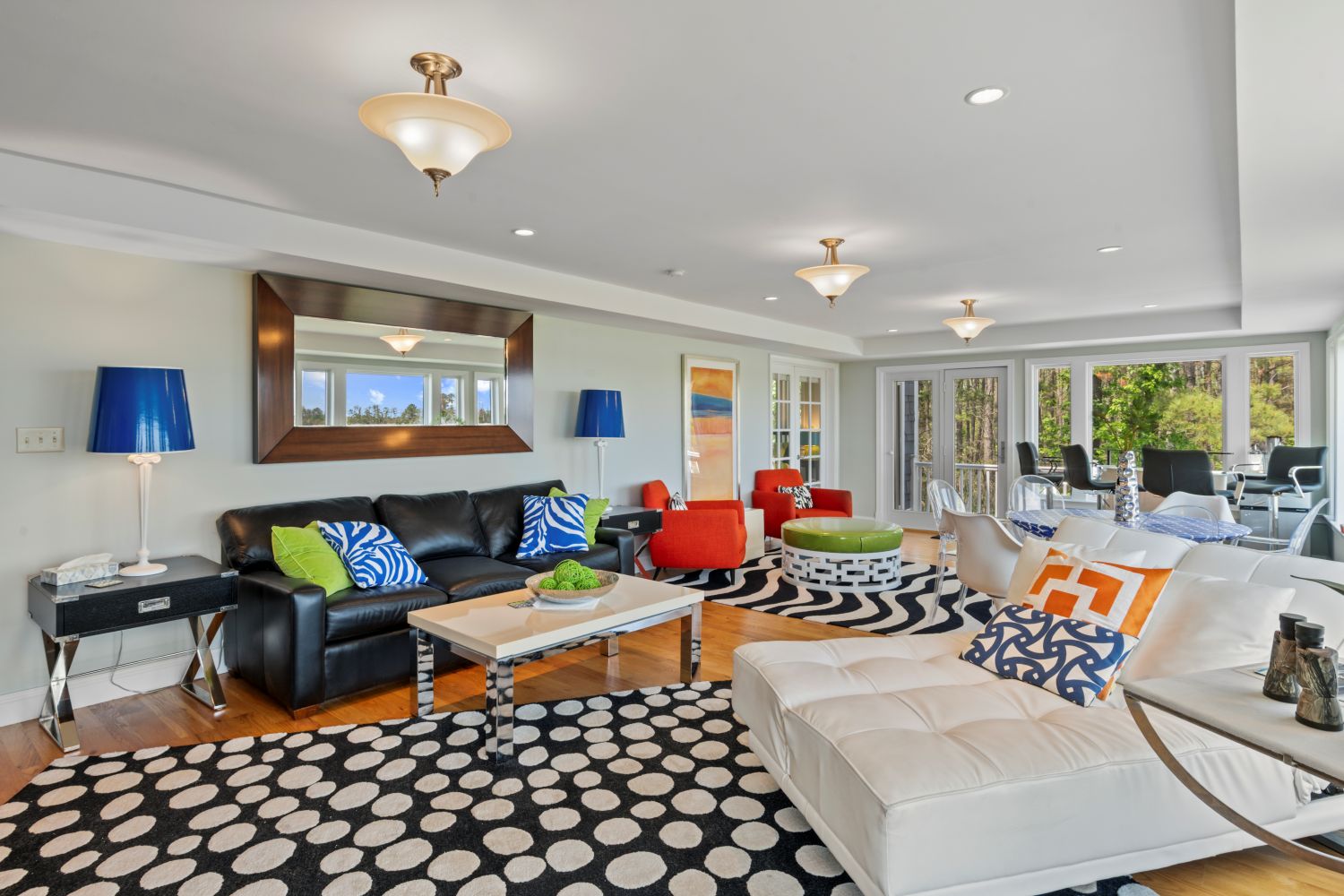
Laid-back comfort meets functionality with easy access to decks, and ensuite.
The spacious family room is a great space for relaxing with family and friends since it offers a range of seating groups from the two sofas for watching TV, the red chairs with a large ottoman for relaxing with a book or quiet conversation and the bar stools at the corner bar area. Double doors lead from the bar area to a deck and the pair of French doors at the corner lead to the primary ensuite.
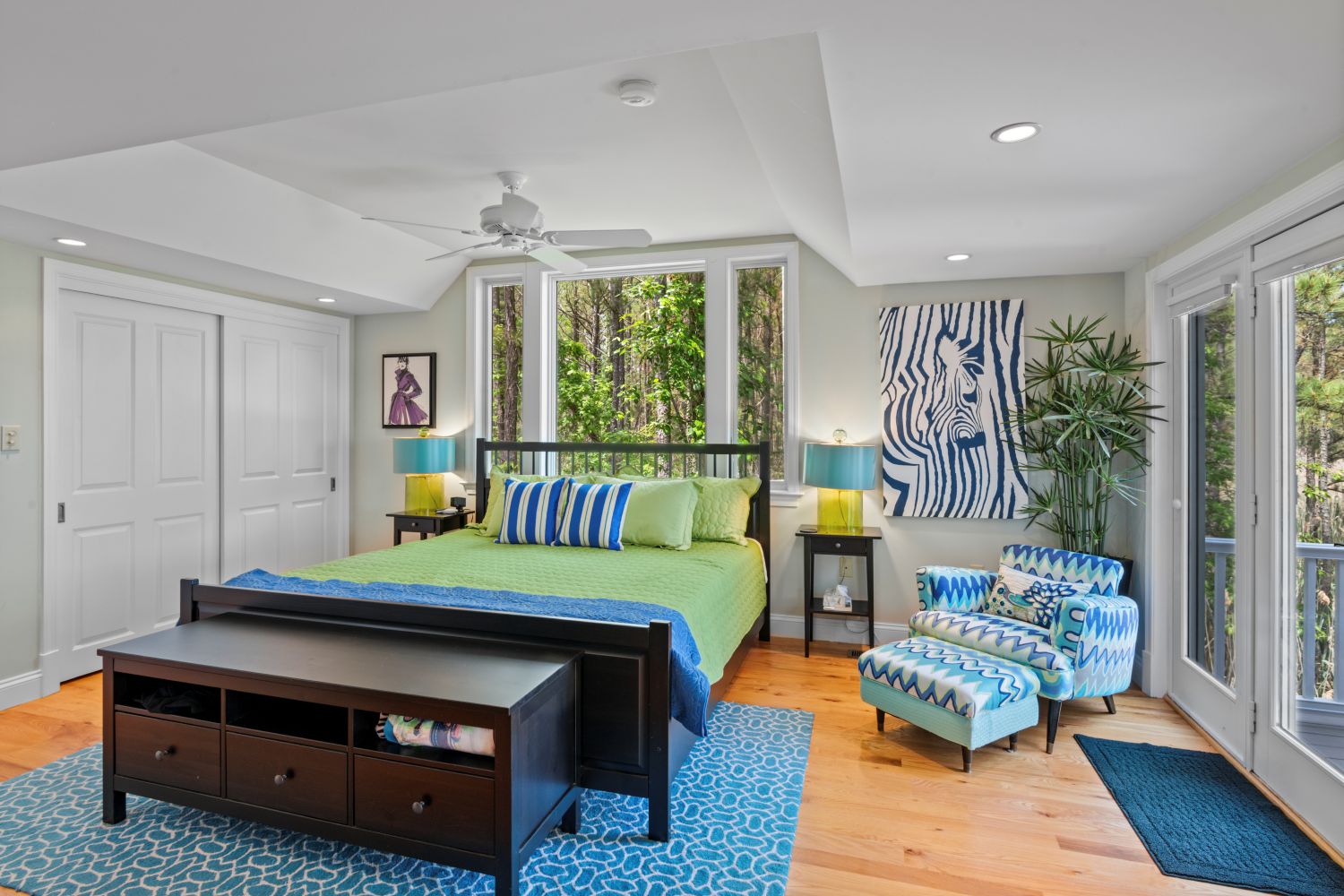
Playful ceiling slopes reflect the serene outdoor hues in a peaceful bedroom retreat.
The primary bedroom is located at the quiet corner of the house. Sloped ceiling planes break up the flat areas for added height and the wide window and the doors to the deck offer abundant sunlight and views of the landscape and water. I loved the hues of this delightful room’s blue and green color scheme and I especially liked how the wavy designs of both the art, the chair and ottoman add a touch of whimsy.
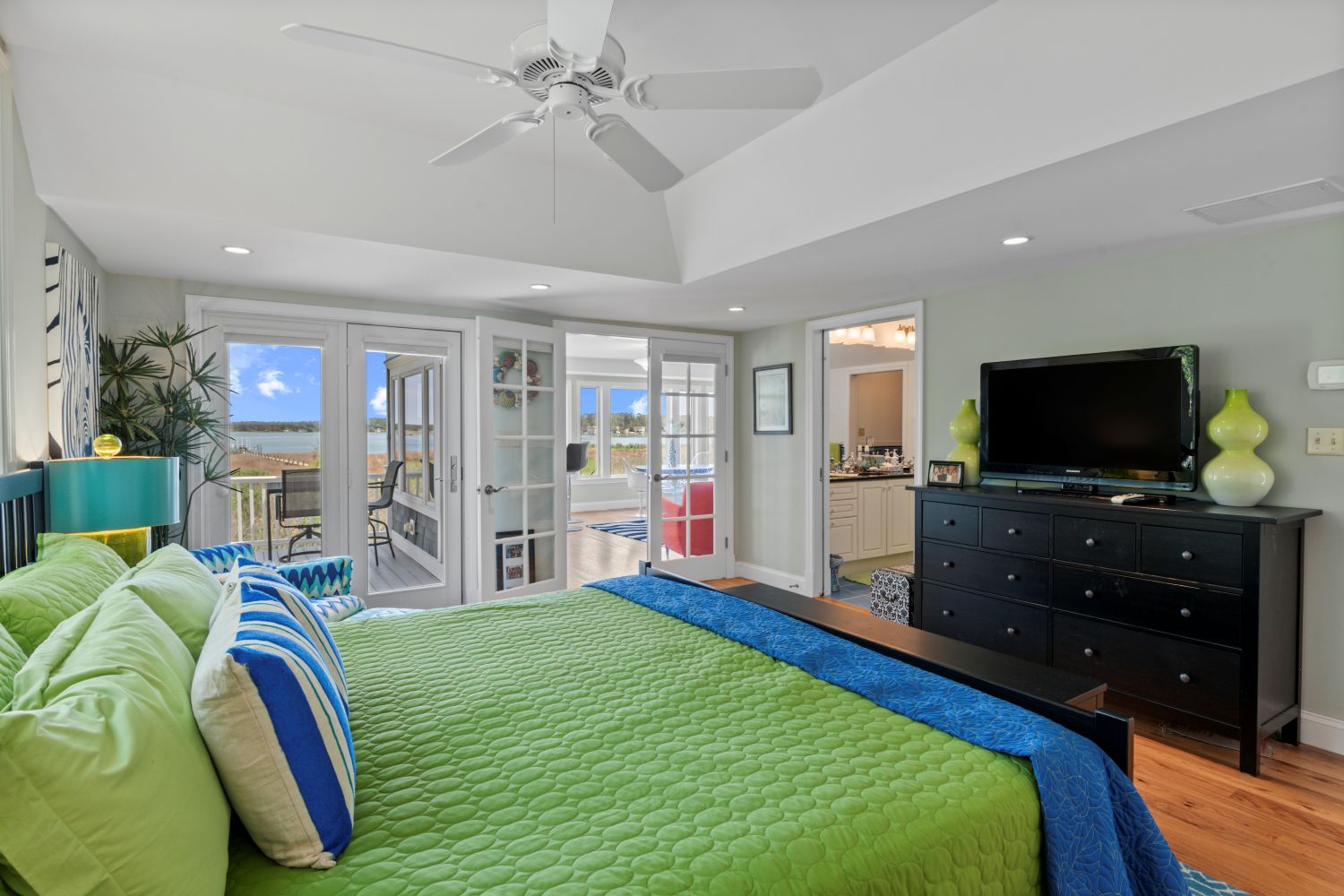
From morning’s first light to day’s end dusk, uninterrupted water views give you an outside-in vibe.
From the bed, one has long views of the water from both the deck and the family room’s windows. The deep soffits contain the HVAC and downlights and the tray portion of the ceiling easily accommodates a ceiling fan at the top of the ceiling.
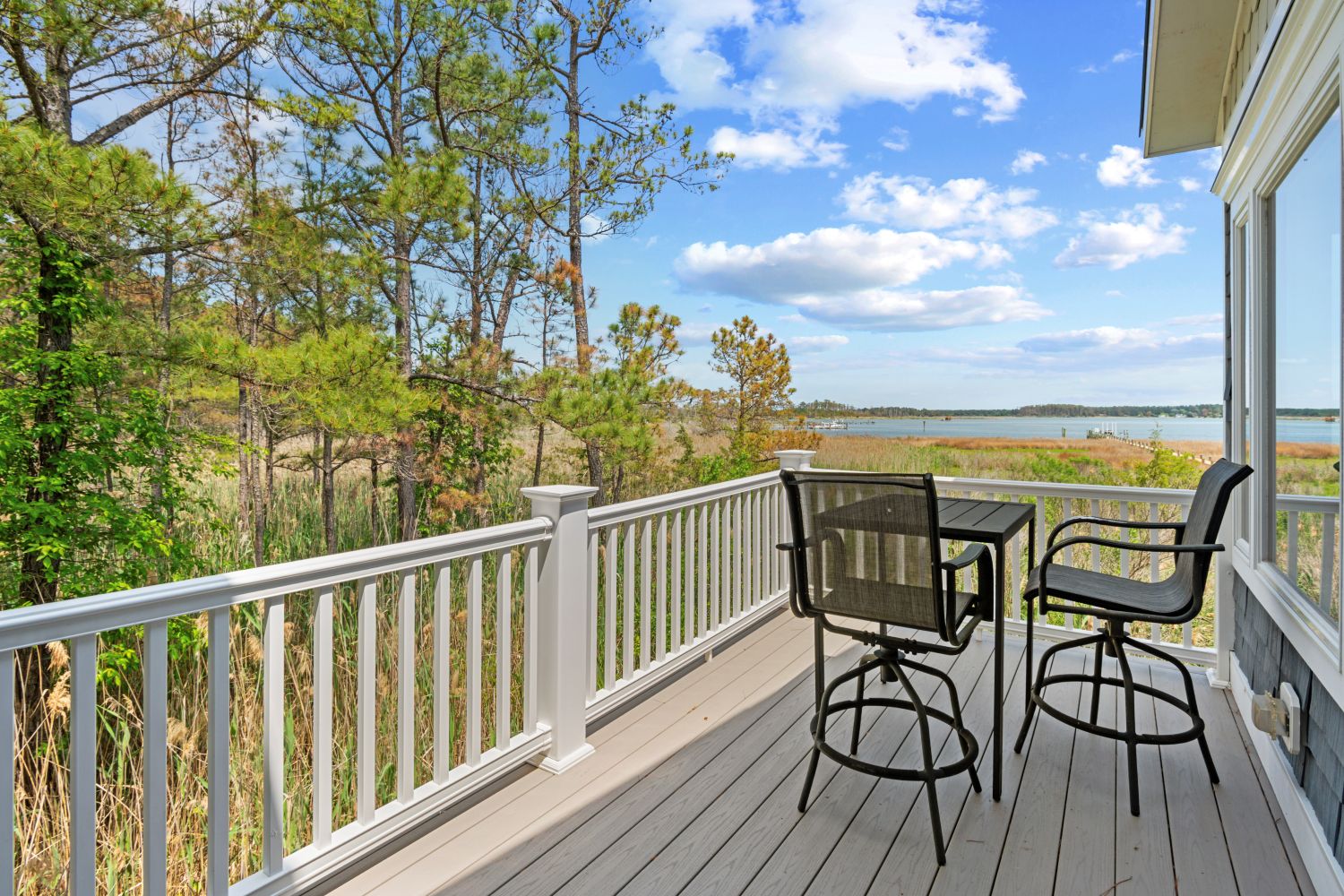
A serene spot for sunrise contemplations or twilight relaxation.
This cozy deck off the primary bedroom and the family room’s bar area is the perfect spot for watching the sun rise over the far horizon or a quiet spot to relax at the end of the day.

Innovative use of glass blocks channels light beautifully into the room.
The five-piece primary bath is located between the family room and the hall to the primary bedroom so it has no exterior window. I admired the Owner’s clever solution of installing glass block at the full height and depth of the shower wall so light filters into the bath from the adjacent hall’s exterior window.
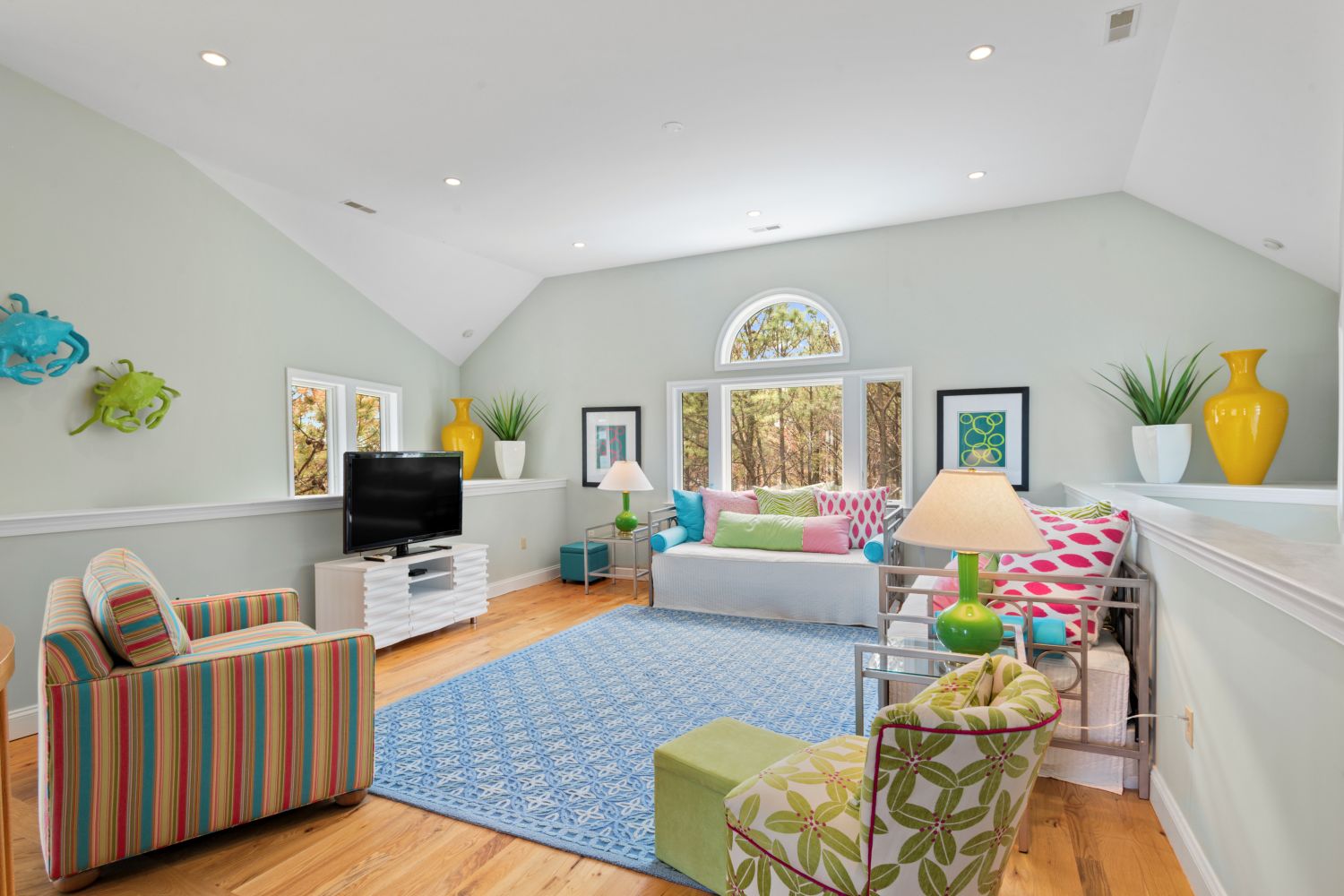
A brightly lit space marries architectural charm with spatial versatility.
The stairs to the second floor open next to a sitting room with delightful interior architecture from the roof’s gambrel shape and clever floor openings. Partial walls surround these openings that become light wells to filter sunlight down to the dining room below. Daybeds provide extra sleeping space for guests.
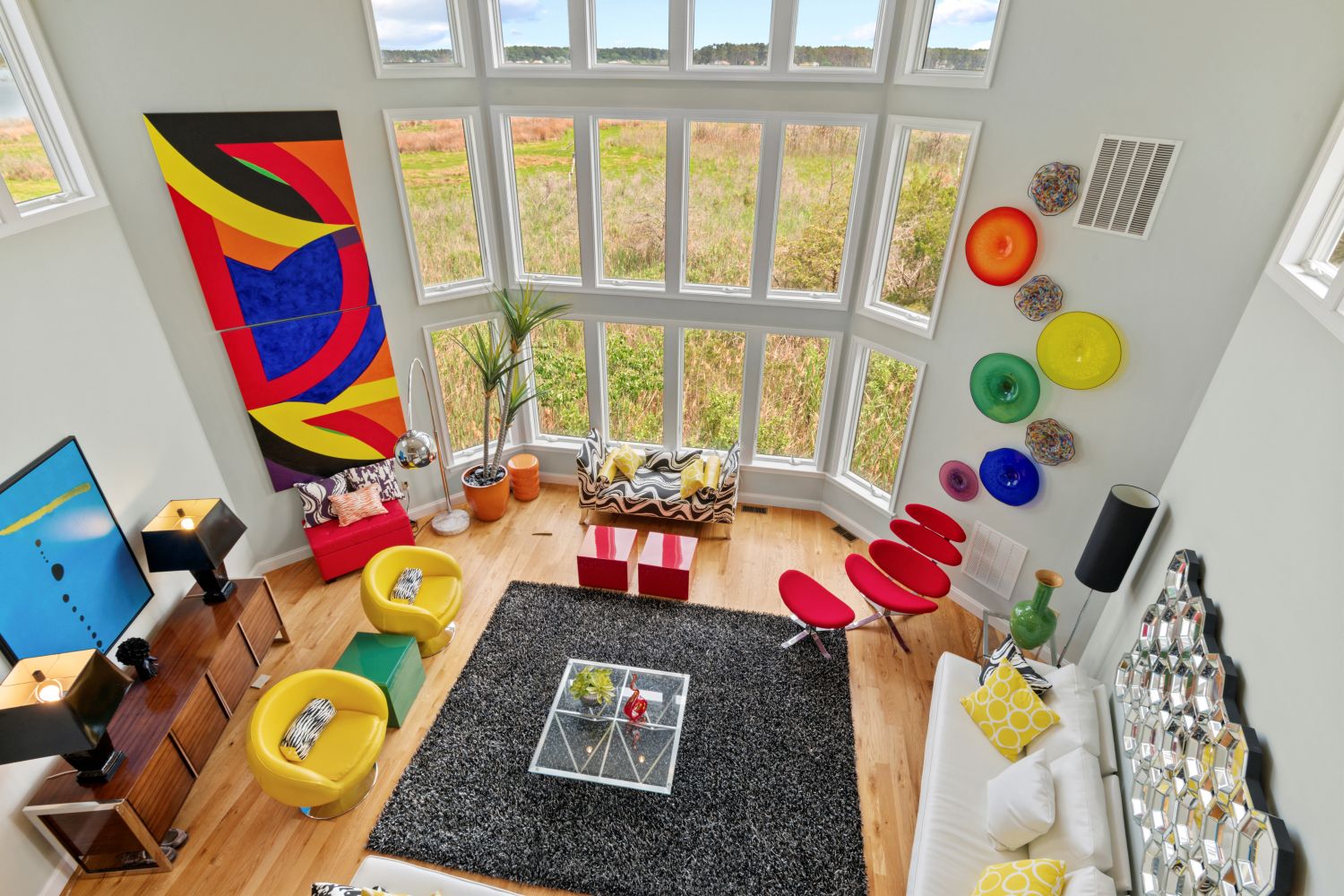
Bird’s eye views extend to Brooks Creek’s untouched beauty and beyond.
My fave part of the house was this view both from the overlook railing down to the living room and also across the upper panes of glass to the undisturbed landscape to Brooks Creek beyond and the expanse of the sky.
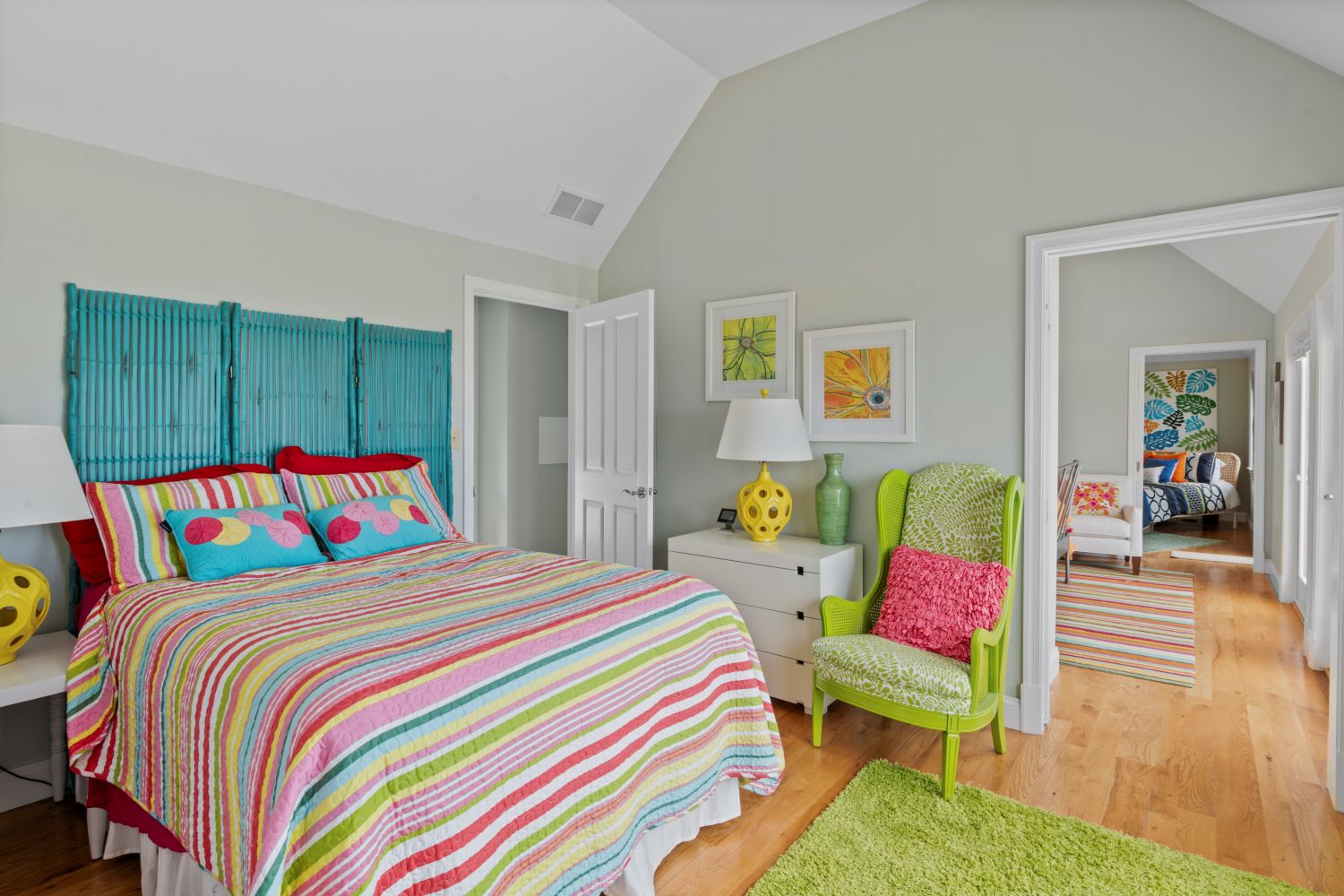
Colorful layers and texture make this space playful yet inviting.
Three guest bedrooms are connected both by the interior hall past two half baths and also by doors between the bedrooms. Each room has a gambrel shaped ceiling for added height and colorful interior design that gives each room its own unique personality. This room’s multi-colored striped bedspread inspired the accents of the textured headboard, rug and chair to creates a delightful space.
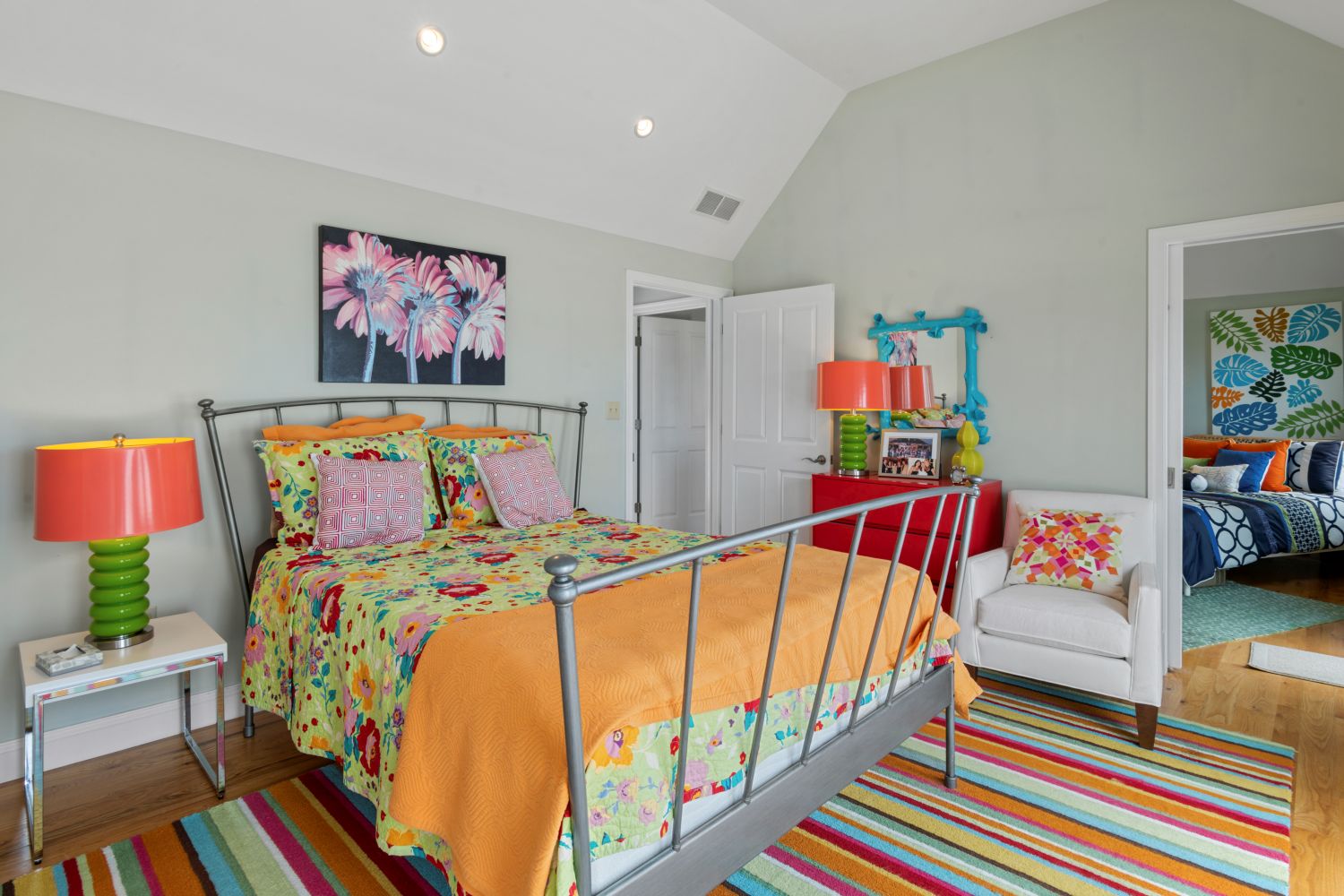
Bright accents and unique design elements enliven another cheerful guest space.
The middle bedroom’s playful flared metal bedframe, multi-colored stiped rug and bedspread with accents of orange in the coverlet and lampshades gives it its unique charm.

A third guest bedroom provides an artistic retreat thanks to sunlight-filled walls and vibrant patterns.
The corner bedroom, with an ensuite bath, has windows on both exterior walls for additional sunlight. Since I am a Matisse fan, this room would probably be my first choice as a guest for the colorful Matisse frameless art and the geometric patterns of the bed linens in blue, white and orange.
The coastal design of this two story house with the main living level above parking and storage areas at grade provides both covered parking and also nestles the footprint of the house into its 11.8 acre site. The only disturbance to the site were the columns to support the two stories of the house above the ground level. Built in 2007 on its point of land, the house’s compact “Y” shaped floor plan created angled walls in the living and dining Rooms that are parallel to the incredible 1,500 linear feet of shoreline for direct views.
The house is zoned very well with the interconnected living-dining-kitchen-family room area and the primary ensuite at the second floor and a sitting room, and the sitting room, three guest bedrooms and baths at the third floor. The living room’s stunning two-story bay window, wrap around windows at the dining room and family room and the wall of windows and doors at the third floor guest bedrooms open the house to the breathtaking views of the landscape and water. The house’s decks and long vistas from the interior rooms offer sweeping, panoramic views of Brooks Creek.
Outdoor amenities also include a private pier with approximately 3 feet MLW (mean low water), complete with water, electric, and a 12,000 lb boat lift that would please boating or fishing enthusiasts. Hunters would appreciate the duck blind on the property and the abundant wildlife that make this site a rare hunting paradise.
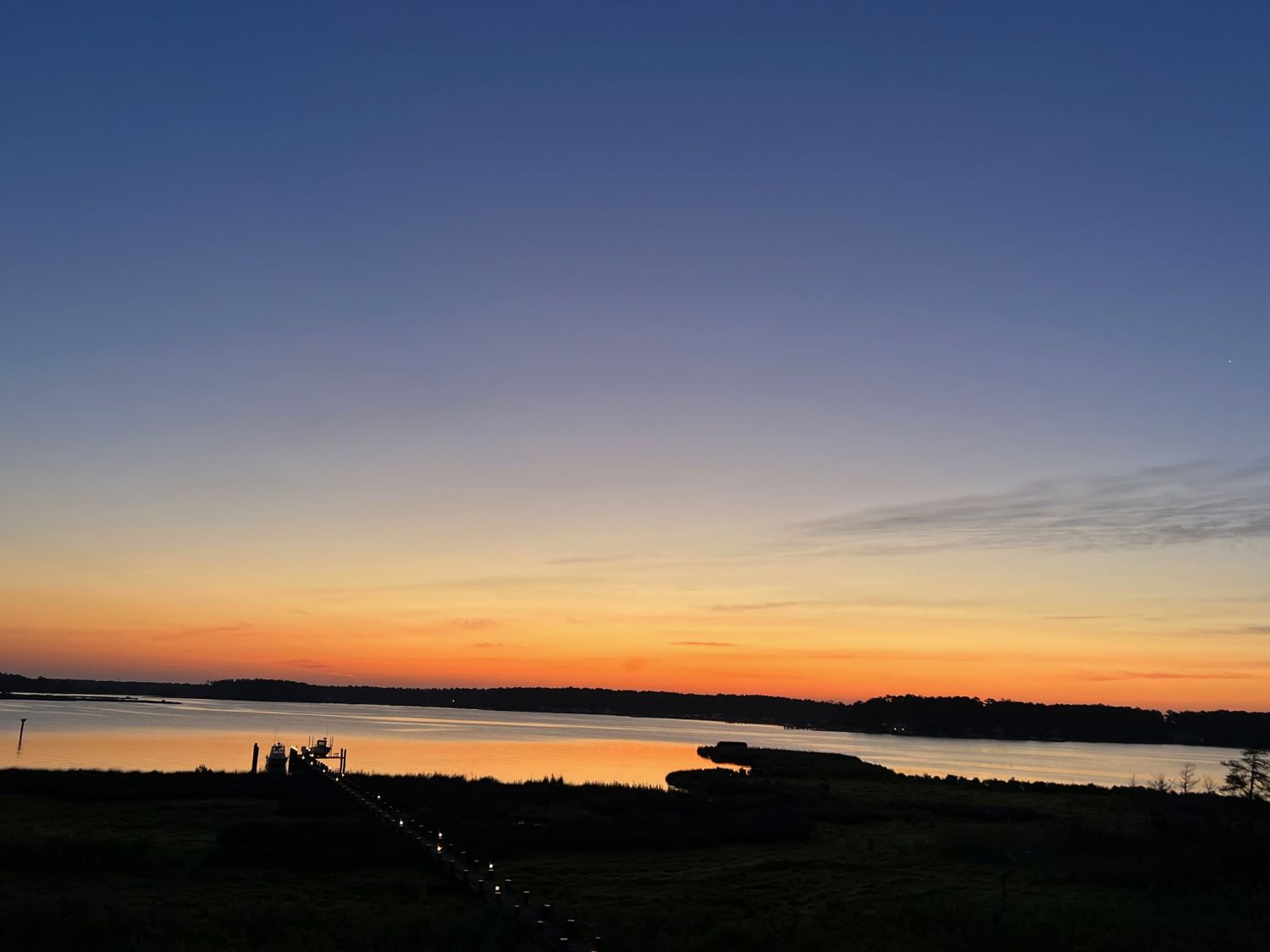
Tranquility blankets Brooks Creek from sunrise to sunset.
From watching the sunrise over Brooks Creek to nocturnal star gazing from the second and third floor decks, this quintessential property offers peace and privacy, only an hour from the Atlantic Ocean beaches and close proximity to Cambridge’s shops and restaurants. All this, and the furnishings are included too!
For more information about this property, contact Coldwell Banker Real Estate agent Gwen Eskridge at 410-822-9000 (o), or [email protected]. For more photographs and pricing, visit www.cbchesapeake.com , “Equal Housing Opportunity”.
Open House: Saturday, July 12th, from noon to 3:00 pm
Photography by Rolfe Wood, 630-222-3098
Contributor Jennifer Martella has pursued dual careers in architecture and real estate since she moved to the Eastern Shore in 2004. She has reestablished her architectural practice for residential and commercial projects and is a real estate agent for Meredith Fine Properties. She especially enjoys using her architectural expertise to help buyers envision how they could modify a potential property. Her Italian heritage led her to Piazza Italian Market, where she hosts wine tastings every Friday and Saturday afternoons.
The Spy Newspapers may periodically employ the assistance of artificial intelligence (AI) to enhance the clarity and accuracy of our content.
The Spy Newspapers may periodically employ the assistance of artificial intelligence (AI) to enhance the clarity and accuracy of our content.
Tom Deininger was born in Boston in 1970. He is a sculptor who works in the style known as assemblage: unrelated, found objects brought together to form a work of art. His sculptures are created with discarded objects that are not biodegradable or recyclable. His work is collected world-wide
He is dyslexic and suffers from ADHD. School was difficult, but he was able to express himself through drawing and making things. Deininger describes himself as “very outdoorsy. I grew up in Norwell, Massachusetts, and I lived in a wooded area with ponds and a river.” He attended Salve Regina University in Newton, Rhode Island, graduating with honors in art. After college he traveled through Europe, Central America, and the South Pacific. He surfed, and he made and sold his art. On this trip to the remote and beautiful beaches of the South Pacific, he saw piles of American plastic trash. He became acutely aware of the damage to the environment created by our consumerist society. Deininger returned to Rhode Island in 1999. He set up a studio in Fall River, Massachusetts. A visit to the Nantucket landfill gave him the idea to make his work three-dimensional, using the thrown-away waste of society.
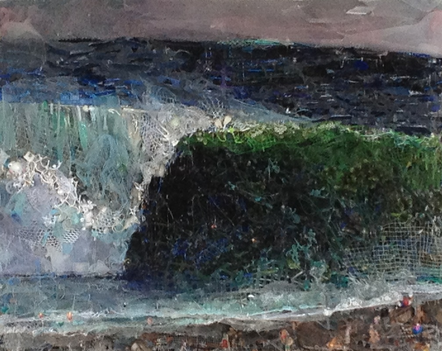
“Wave 1” (2012)
“Wave 1” (2012) (3’x4’x2.5’) was inspired by Deininger’s love of surfing. Made entirely of found plastic objects, it depicts a large white wave, curling, and pounding the beach–a surfer’s wave. Bits of plastic webbing are visible. This work is small in scale. “Wave 3” (2012) (not shown) (6’x8’x3’) and other works are even larger. He chose to depict what he loved in nature and the destructive effect of consumerism on the environment. He contributes 50% of the sale of his sculptures to the organization Narragansett, Rhode Island Save the Bay.
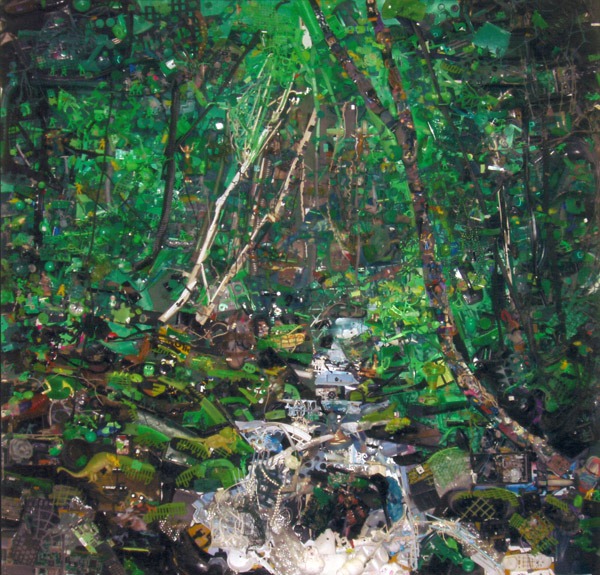
”Poland Springs” (12’x20’)
“Poland Springs” (12’x20’) (undated) was made from plastic water bottles the Maine corporation Poland Springs uses to contain its product. The waterfalls, plants, and trees of the region create a refreshing view of a heathy and pleasing environment. Pure, fresh, clean water is the product. It takes three liters of fresh water to make one liter of Poland Springs bottled water.
The organization Fortune Brainstorm Green has sponsored annual conferences beginning in 2008 to focus attention on issues of sustainability by bringing together leaders from government, business, and other organizations. Deininger was commissioned to create a 20’x10’ backdrop (not depicted) for one of the conferences. =

“Plastic Paradise”
Deininger once commented, “I go to the beach about four days a week, and I pick stuff up. It’s hunter-gatherer, to be honest. And now I’m getting donations from people on Instagram. They don’t like throwing this stuff away.”
“Plastic Paradise” (12’x20’) (undated) is a depiction of a flower-filled meadow, a tall green forest, a rocky mountain, all set under a clear blue sky. Perhaps Deininger hoped the ironic title would make people think. In a 2024 interview with Yahoo news, he stated, “I don’t think we’re alarmed enough. Everyone’s not alarmed enough, enough of the time, is my fear. We should all be petrified and willing to do whatever it takes.”
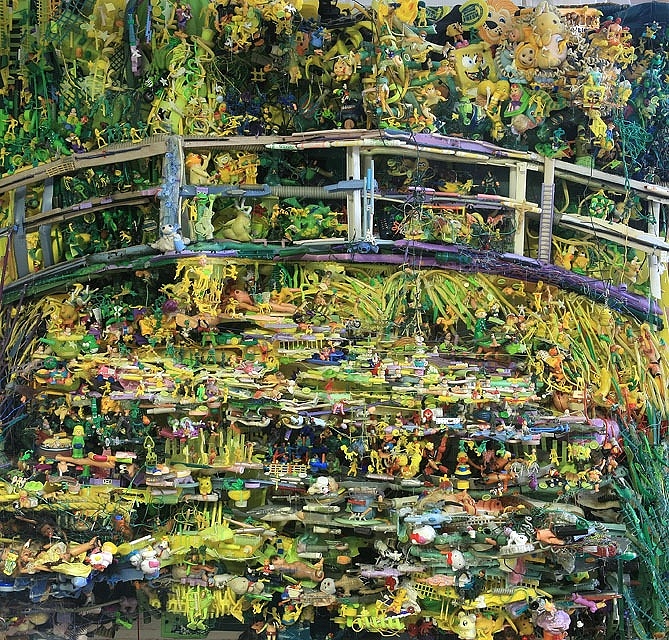
‘Stroking Monet” (2010s)
Deininger occasionally selects known works to recreate as assemblages. “Stroking Monet” (2010s) recalls Monet’s “Japanese Footbridge” (1899) in found plastic junk. Deininger dumpster dives, rummages through people’s garbage cans on trash day, and picks things up all the time.
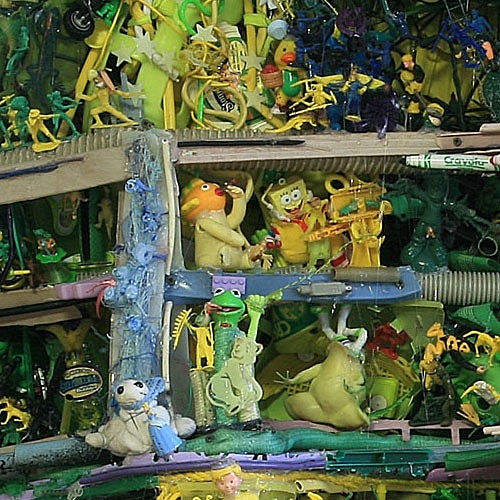
‘Stroking Monet, detail” (2010s)
So, what is it all about? When viewers are able to look at his work up close, they experience a totally new reality. Plastic Sponge Bob Square Pants, Barbies and Barbie parts, Kermit the Frog, abandoned plastic toys, bottle caps, cassette tapes, wire, plastic syringes, plastic bags, and more, all come together to create an entirely different impression. The juxtaposition of parts is funny, sad, alarming, violent, bizarre, and sexual.
Deininger offers his point of view: “And so you’ve got one thing up close and it coalesces into something else all together from a distance. So, just the idea of what is reality, what is truth, has everything to do with perception…. It reminds me of how slippery it can be, what is real and what is true.”
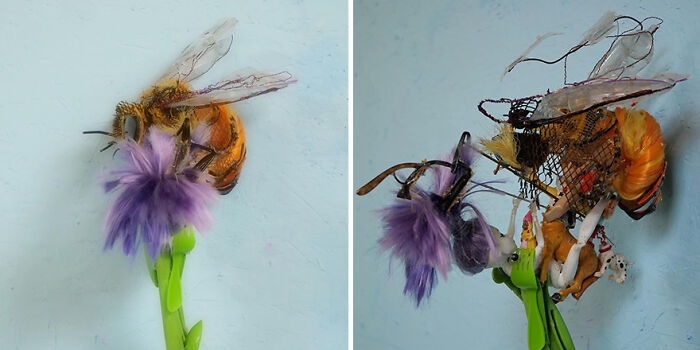
”Honeybee” (undated)
In more recent years, Deininger has begun to create his assemblages with images of birds, fish, and other animals. In his interviews he talks about his process. “Honeybee” (undated) was made from plastic bristles, netting, wire, toy figurines, a plastic German Shepherd, a little man holding a long stick, Shaggy and Scobey-Doo figures, a doll’s head, green plastic forks, and half a pair of sunglasses to represent the eye, among other things.
This double image captures both sides of the sculpture, similar to what a viewer would be able to see when the work is on display. Glueing, wiring, drilling, and pinning are among the processes used. Creating the basic sculpture takes about a week, with more time needed to refine the final image.
Deininger researches each animal: “To cull through hundreds of images of bees and find the one you want because you can clearly see the eye or the thorax—you get to understand the granular details of variation within a species.”
Deininger observes, “We tend to dismiss things that are inexpensive and don’t look at their beauty overall. But when you can take something out of context and put it together with a variety of other things, you can coax a new definition out of it and maybe a new purpose.”

”Osprey” (2023)
Deninger talks about birds: “I’m just really fascinated with them. Fascinated by the physical engineering and also there is a wonder about birds…. It’s often about things coming down from the heavens. Birds occupy this space that isn’t available for us to occupy. I think humans have always been attracted to birds in a spiritual way.”
The subject of the sculpture “Osprey” (2023) (18”x12”x39”) is well-known to those of us who live on the Mid-Shore. The retirement community Heron Point maintains an Osprey nest with a video camera set up so that residents can watch 24/7 during the season.
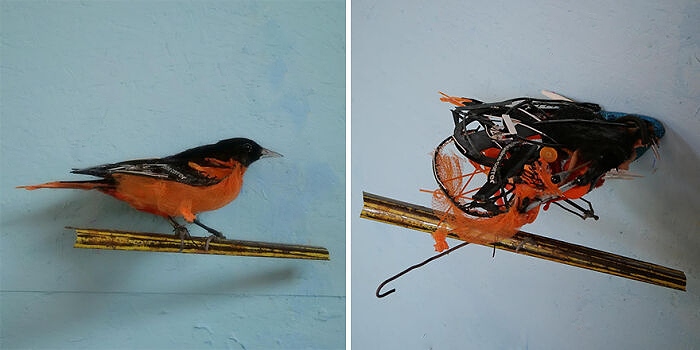
“Baltimore Oriole” (2023) (5”x11’’x17’’)
It is possible to see both sides of another of Deininger’s sculptures, Maryland’s State bird.
In 2025, Deininger started a permaculture farm, an agriculturally sustainable and self-sufficient ecosystem, to take care of rescued animals.
In several interviews over a period of time he offered his point of view;
“There’s so much junk around us that we can recreate the natural world.” (The Provincetown Independent, 3/212/25)
“Yes, we can call these objects masterpieces.” (Yalik Ak, 7/9/2014)
“You know, nothing changes if we do the same thing over and over again, and just walk into an ecological crisis that is irreversible. It’s about adopting a new perspective.” (Blue Dot Living, 2025)
Beverly Hall Smith was a professor of art history for 40 years. Since retiring to Chestertown with her husband Kurt in 2014, she has taught art history classes at WC-ALL and the Institute of Adult Learning, Centreville. An artist, she sometimes exhibits work at River Arts. She also paints sets for the Garfield Theater in Chestertown.
The Spy Newspapers may periodically employ the assistance of artificial intelligence (AI) to enhance the clarity and accuracy of our content.

A timeless symmetry of gabled roofs and Flemish brick bond greets visitors at the threshold of history.
Mt. Pleasant was built in the early 1800’s for the happiest of reasons-Daniel Cox Hopper built this brick, one room deep, three-story house so he could carry his new bride over the threshold of the double doors into the center hall of their new home. As befitting a man who was a prominent local attorney and planter, member of the Maryland House of Delegates and a Lieutenant in the Maryland Militia during the War of 1812, he built the house in style of the day, a transitional Georgian to Federal Manor house on its original 383 tract of land that dates back to the 1600’s.
Today the house sits on 2.7 acres, surrounded by farm fields and vistas of the landscape that has remained remarkably unchanged for over two hundred years. As I came to the end of the allee of trees along the entry drive, I paused to savor this house’s elegant simplicity of gabled roofs, the harmonious symmetry of windows and doors and how the massing telescopes down from the 2-1/2 story main wing to the 1-1/2 story wing.
As I walked up the steps to the entry double doors, I noticed the “put-log” holes in the brick headers that had supported scaffolding during construction and the lovely Flemish bond of the brick on the front façade.

Subtle remnants of whitewashed brick highlight the preserved craftsmanship of centuries past.
One of my favorite courses of my architectural education was architectural history. The professor considered older houses to be living things that can convey clues about the styles or details of an earlier period, if one has the time and patience to seek them. This house was very lucky that in 1988, a young family moved in and their mantra became how best to preserve the history of the house, while adapting a two centuries old house to the needs and wants of a growing 20th century family.
As I walked around the house, the only later addition is the old tin-roofed porch that became the family’s mud room, pantry and powder room. The areas of white brick indicate that the house was once painted and I admired how it gave the facades a look more refreshing than a monolithic brick façade would have been.

Fields radiate serenity, mirroring the unchanged landscape from the home’s storied past.
After studying the rear façade, I turned around to this serene endless vista of shades of green from the fields, still owned and farmed in stewardship by two generations of the Ward family, edged by mature trees. I marveled at how gorgeous the thick green grass was that seemed like a plush carpet with striations of deeper green. The vista reminded me of how the original acreage must have looked during the Hoppers’ tenure.
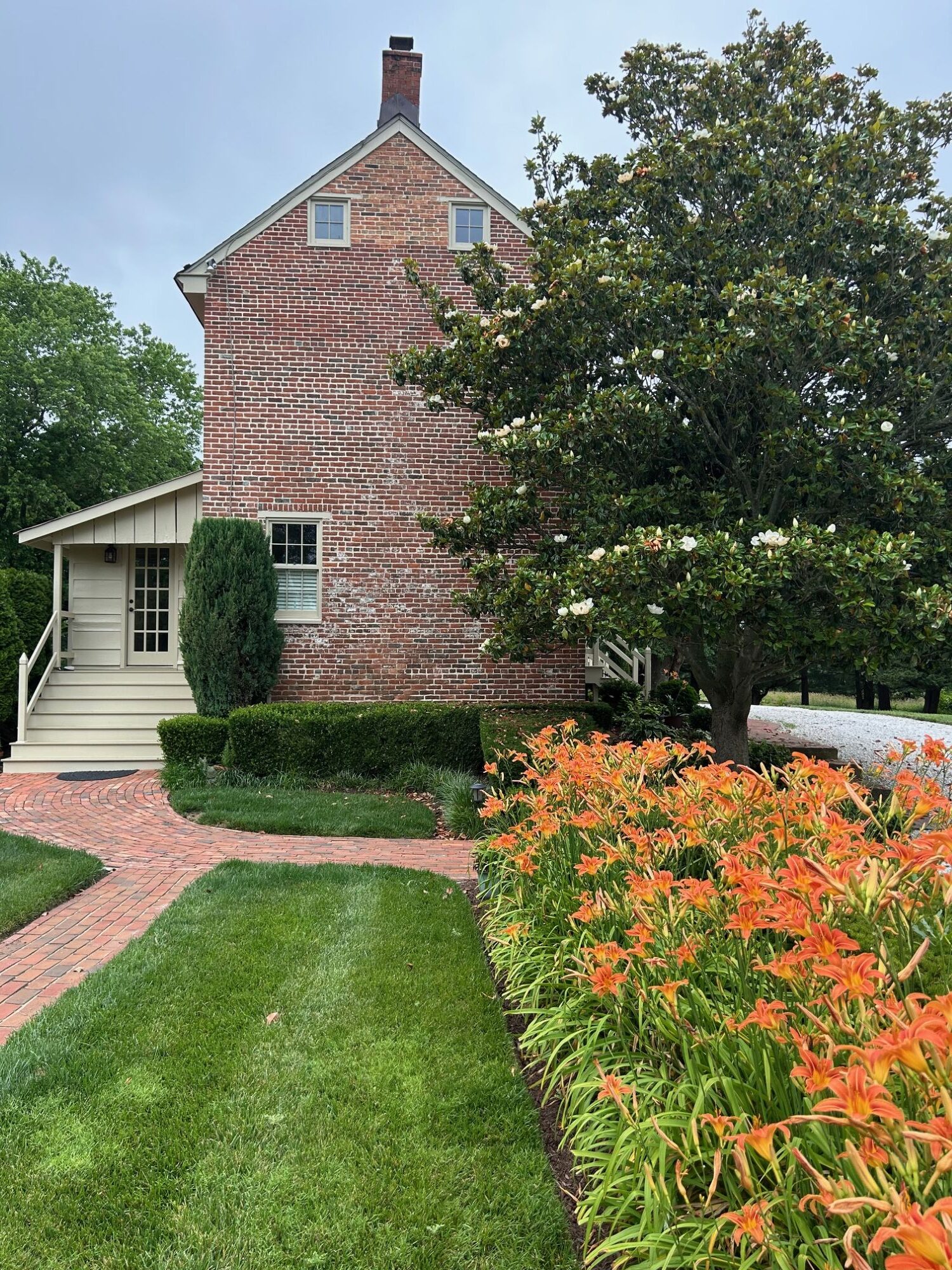
Textured brick meets the gentle sweep of garden pathways in a vivid interplay of color and form.
I could not resist taking this photo of the juxtaposition of the 1-1/2 story wing of textured brick against the wood cladding of the shed roofed porch, in its setting of the lighter colored brick path, thick green grass, tall orange day lilies gently swaying in the breeze rand the majestic Magnolia in bloom.
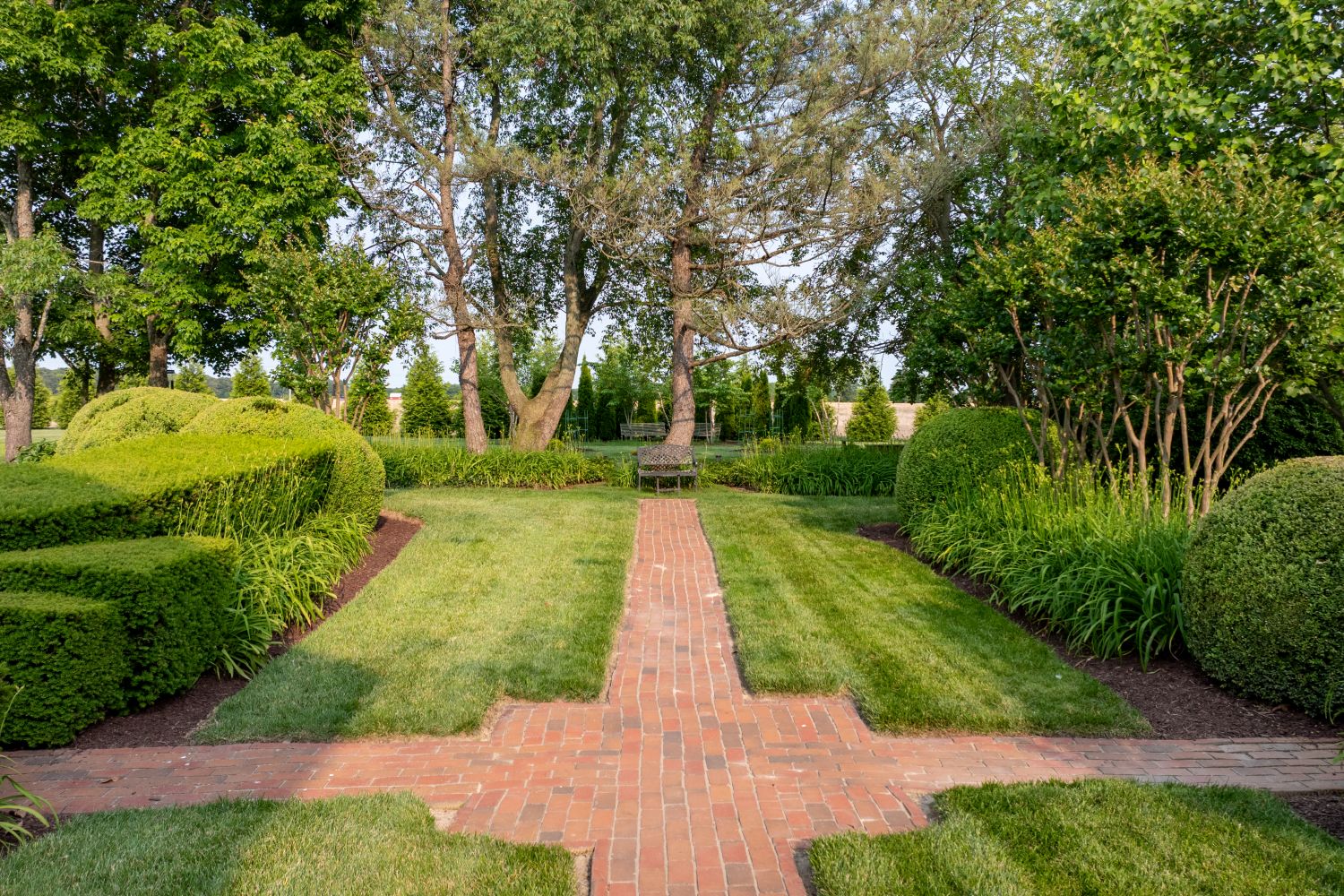
Historic flora connect guests to Jefferson’s Poplar Forest and Washington’s Mount Vernon within this tranquil haven.
The crossroads of the brick path illustrates how one can reach the gardens from both the parking area and the shed roofed addition to the house. The Listing Agent met me in the garden and pointed out the tall Tulip Poplar that once was a mere seedling in Thomas Jefferson’s Poplar Forest Plantation and the yews and boxwoods that were grown from cuttings from Mount Vernon, George Washington’s home.

A breezy pavilion offers alfresco dining and relaxation overlooking a garden steeped in heritage.
The current owners installed the pool and the spacious pavilion open to the breezes is a delightful outdoor room with its view of the garden. The pavilion’s size easily accommodates space for both relaxing on the wicker furnishings or dining al-fresco.

Precision-crafted panel doors frame vistas that once provided natural cooling to this architectural gem.
The current Owners wanted to preserve the original entry doors at both the front and rear of the center hall from extreme weather. They located a craftsman in Oregon who built another two sets of double mahogany raised panel doors whose dimensions were a perfect match to the original doors. At the time the house was built, having doors and windows directly opposite each other provided natural cooling
Over the front entry doors is the original transom, with its muntin profiles that were the prototype for the custom design of the thirty-two new Marvin “Ultimate” insulated windows that replaced the older leaky 1907 “replacement” windows on all the facades. The beautiful antique pieces in the foyer on the original pine flooring were harbingers of more treasures to come.

Panoramic windows and a stately fireplace anchor this room of elegance and light.
To the right of the center hall is the Drawing Room; in the hierarchy of the house’s rooms, it is the most prominent space and the primary entertaining space. The room’s details reflect its prominence such as the largest windows in the house, with angled side wood panels to reflect more light, the largest fireplace in the house with its surround and mantel embellished with columns, pilasters, and panels of reeding, and the chair rail around the room that blends into the center hall’s chair rail. After many, many layers of painstaking removal of paint, the nuances of the fireplace’s design take its pride of place as the focal point in this exquisite room. I admired the colors of the large Oriental rug, the neutral upholstered furnishings and the warmth that only wood antiques can bring to a space.
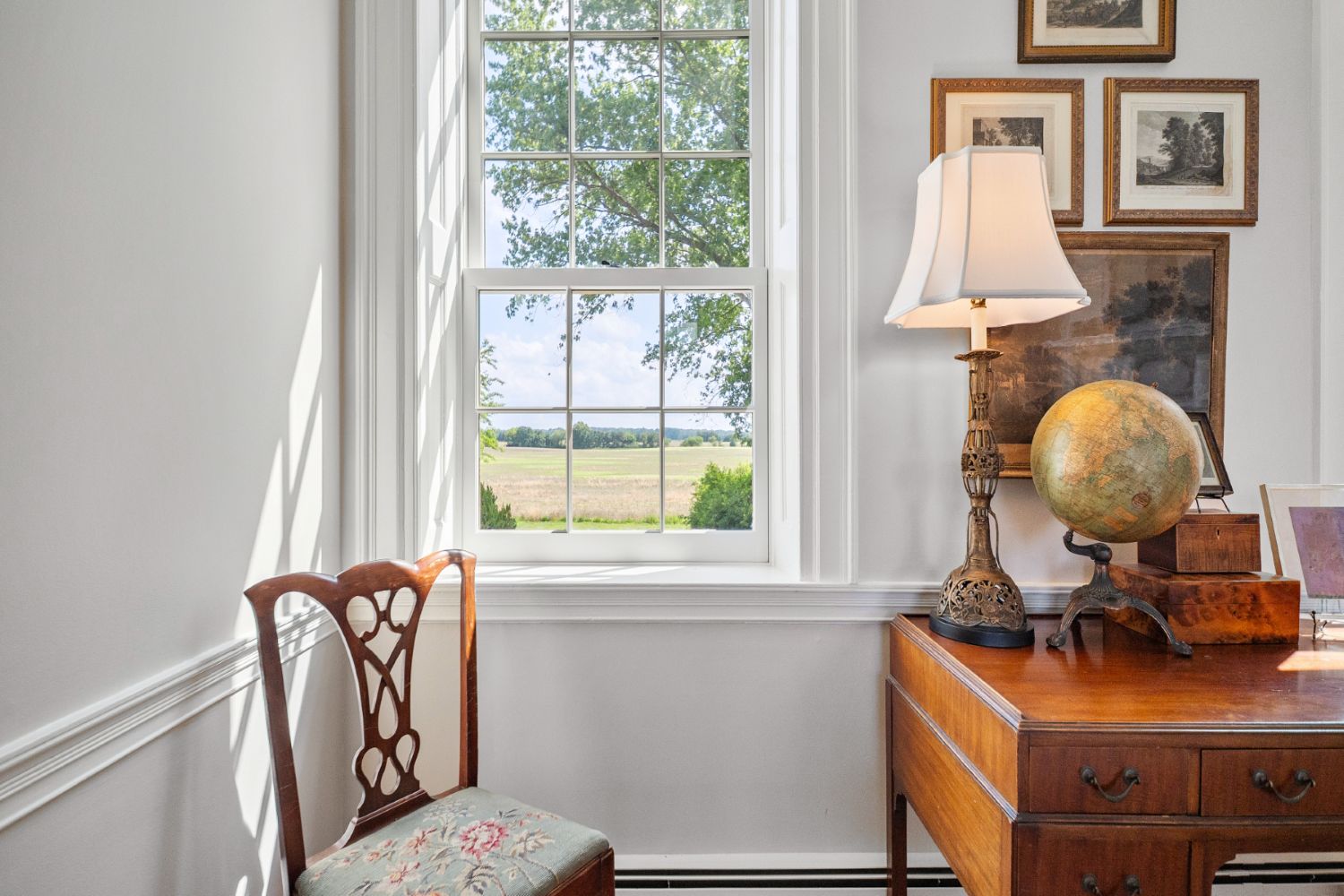
Graceful moldings and serene vistas unite interior artistry with exterior splendor.
Throughout the house, careful arrangements of furnishings and art give this house its distinctive personality. The large window at a rear corner of the Drawing Room offers a long vista over the farm fields to the woods beyond. I especially liked how the moldings around the windows gracefully meet the horizontal line of the chair rail and how the soft light gray walls and white trim become a serene backdrop to the interior design.

Georgian-inspired lighting and millwork elevate the understated refinement of this dining space.
Second in the hierarchy of the rooms is the Dining Room off the center hall. The windows are not as large as the Drawing Room, the fireplace is smaller and the chair rail is not as elaborate as the one in the Drawing Room. The rug is sized to accommodate the table and the extra chairs. I wondered if the pendant light was the work of the artisans at Deep Water Landing in Chestertown, as the Georgian design would be quite appropriate.

A cabinet’s wear tells tales of generations, blending bespoke craftsmanship with historical traces.
The bespoke cupboard in the space between the fireplace and the rear corner of the Dining Room was originally built to contain the china, crystal and silver, as well as wine and liquor. The cupboard’s hardware was lost many years before the current Owners moved in. The notched areas on one side of the doors are evidence of many hands in the past that opened and closed the paneled doors. Before I passed through the doorway leading to the kitchen, I noticed how the side wall of the fireplace has been peeled away to reveal the original plastered wall and remnants of wallpaper. This detail and several other elements throughout the house illustrate the original materials.
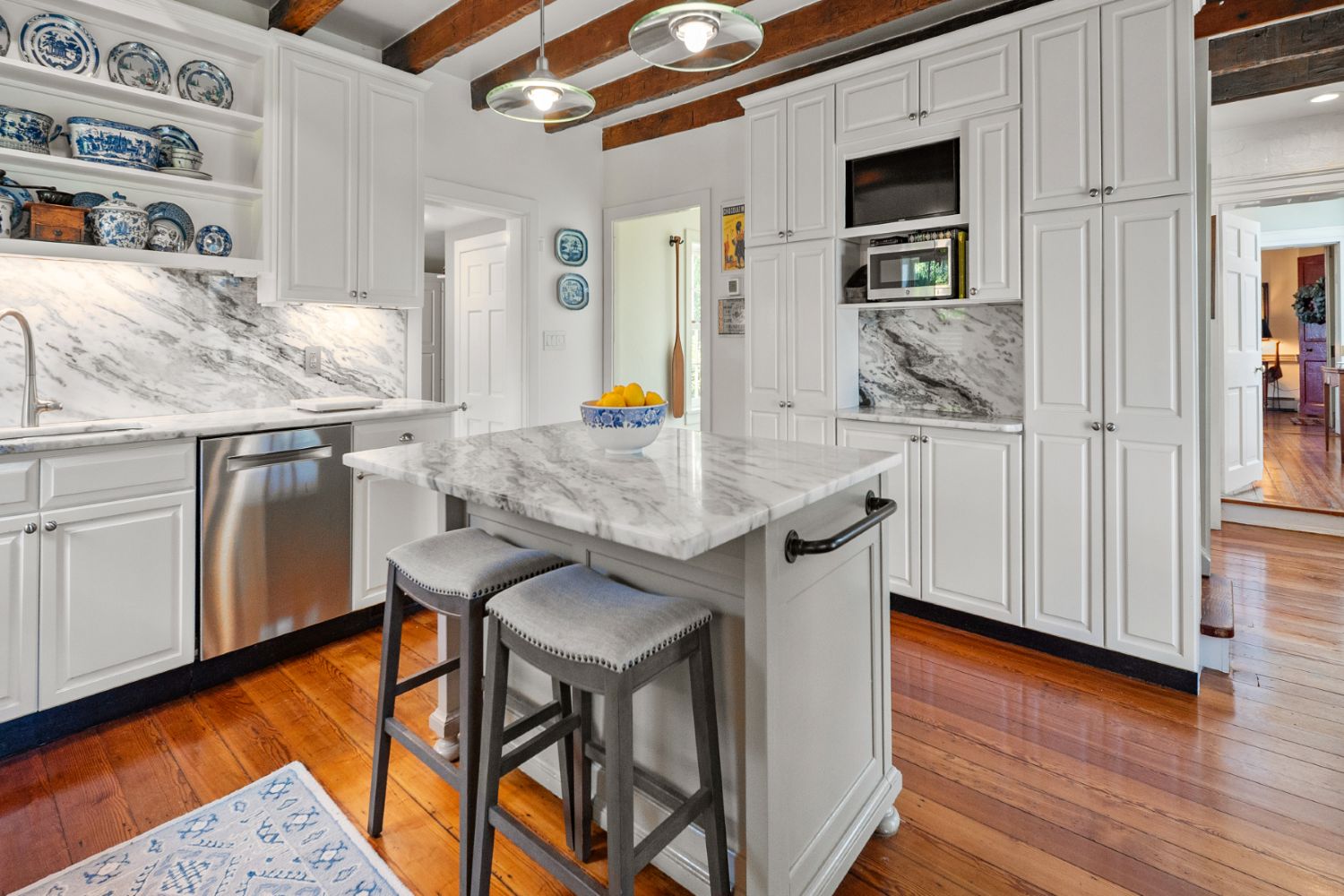
Reclaimed pine floors and exposed beams merge the past with modern functionality in this striking kitchen.
Past the Dining Room is the former pantry that is now a laundry/service room and a secondary stair to the upper part of the kitchen wing. Seeking insights about the original layout of the kitchen, the current Owners reached out to old family and friends who were well acquainted with the Robinson family, who lived at the house when it was dairy farm at the turn of the century. Over a thirty year period, the current Owners have transformed the space with painted maple cabinetry, Brazilian marble countertops and backsplash. The exposed beams were refinished and sealed and the brick chimney at the side wall was left exposed, then repointed and painted white to blend with the cabinetry. The beautiful pine floors were reclaimed from William Paca’s old farm house on the site of the Wye River Plantation, the home of the Maryland signer of the Declaration of Independence. I especially liked how well the white cabinetry highlighted the Owners’ beautiful collection of blue and white ceramics.
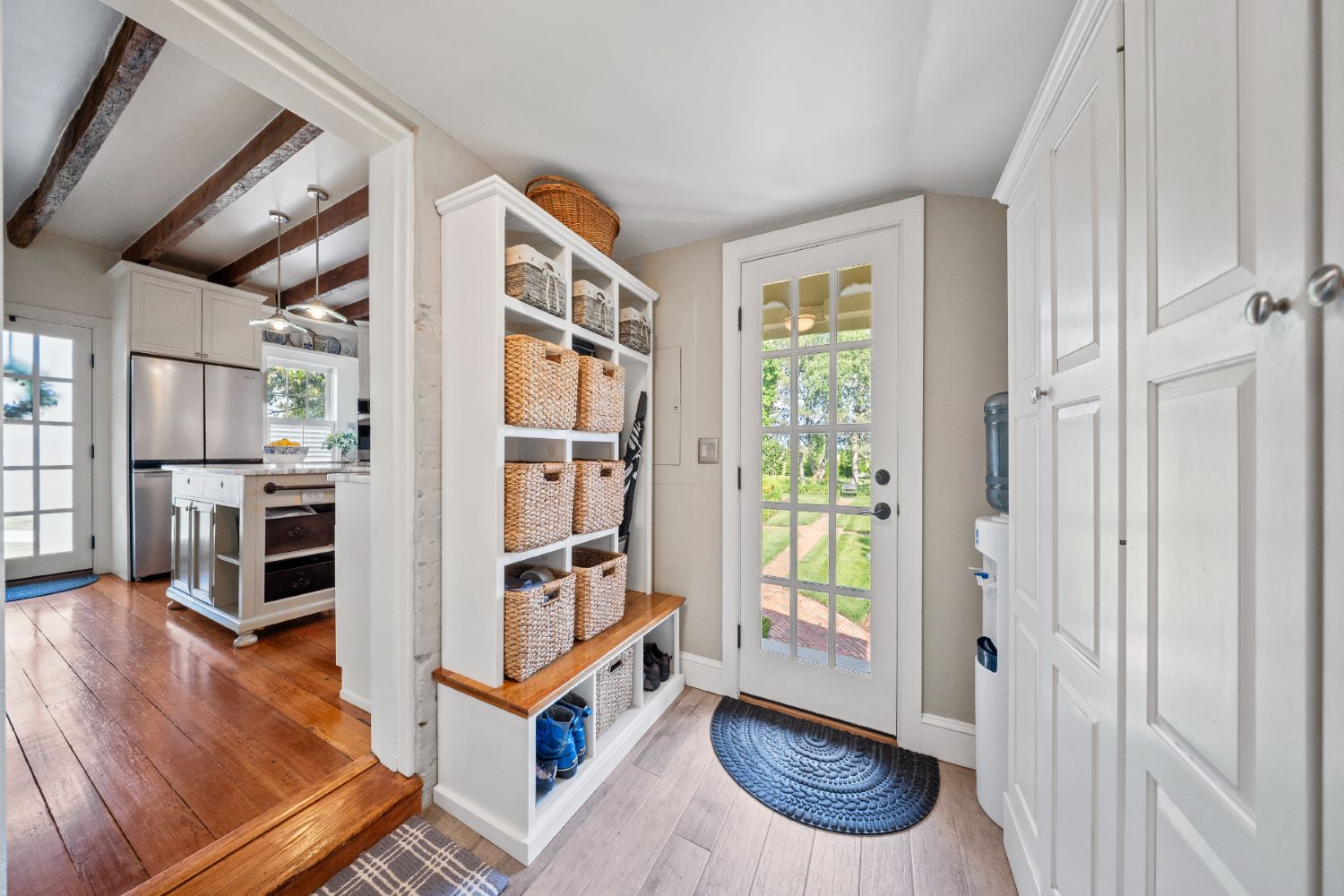
Custom cabinetry optimizes utility while retaining the architectural charm of the original tin-roofed porch.
The current Owners enclosed the old back porch with its original tin roof for a Mud Room/Pantry. A wall of bespoke cabinetry with a mix of paneled doors to access pantry items is opposite open shelves containing baskets of storage for each family member. The lowest cabinet is deeper so it can also be used for sitting while one takes off boots or wellies. The French door brings light into the room and offers a view of the garden. There is also a small powder room for convenient clean ups after gardening. The stairs to the cellar are also located here.

Vaulted arches and brick pilings craft a timeless space, perfect for storing the house’s cultural narrative.
On my tour of the grounds before I came into the house, I had noticed a large half moon shaped opening that had been bricked in at the side wall of the house. I learned that the opening had once been the only access to the cellar. The current Owners discovered a trap door with a folding stairway and remnants of old limed whitewash on each side of the stair. At each end of the cellar, I marveled at the foundation of massive brick pilings and the vaulted relieving arches at the chimneys’ exterior walls.
As the Weekend Wine Woman at Piazza Italian Market, I noted that the rows of wine were resting on racks in this underground space ‘s perfect temperature for storing fine wine. The cellar also originally contained a Larder where butchered meats and fowl awaited cooking or were larded in fat for preservation.
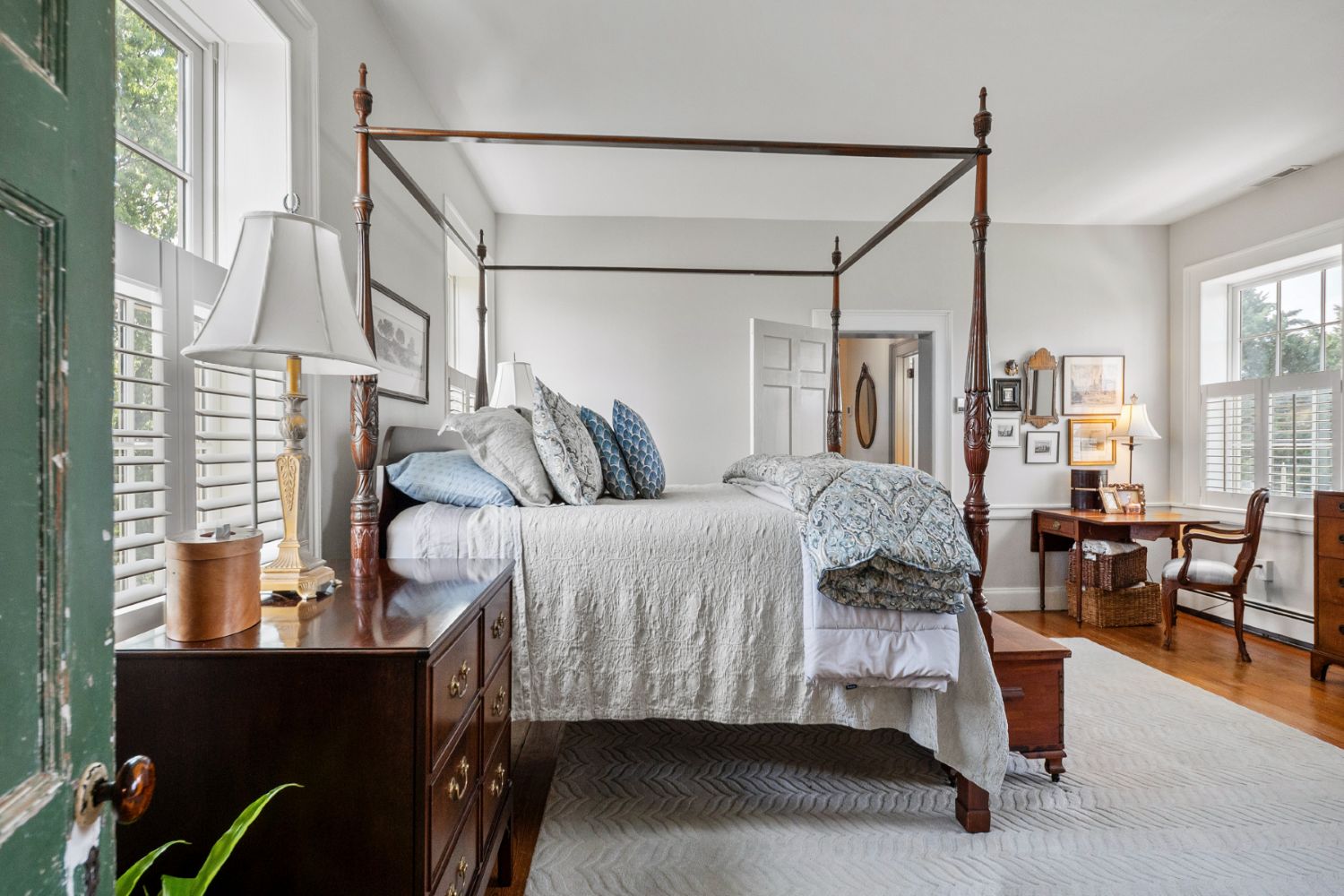
Serene hues complement four-poster elegance within a sunwashed, tranquil retreat.
At the second floor, the spacious Primary Ensuite begins with the bedroom over the Dining Room. Steps down to the 1850’s era wing now contains the Primary Bath, the secondary stairs to the Kitchen, Primary Dressing Room and Office. The bedroom’s four poster frame fills the space without infringing upon the spatial volume and the soft colors of white and blue create a serene retreat. The original door has been saved in its original state.
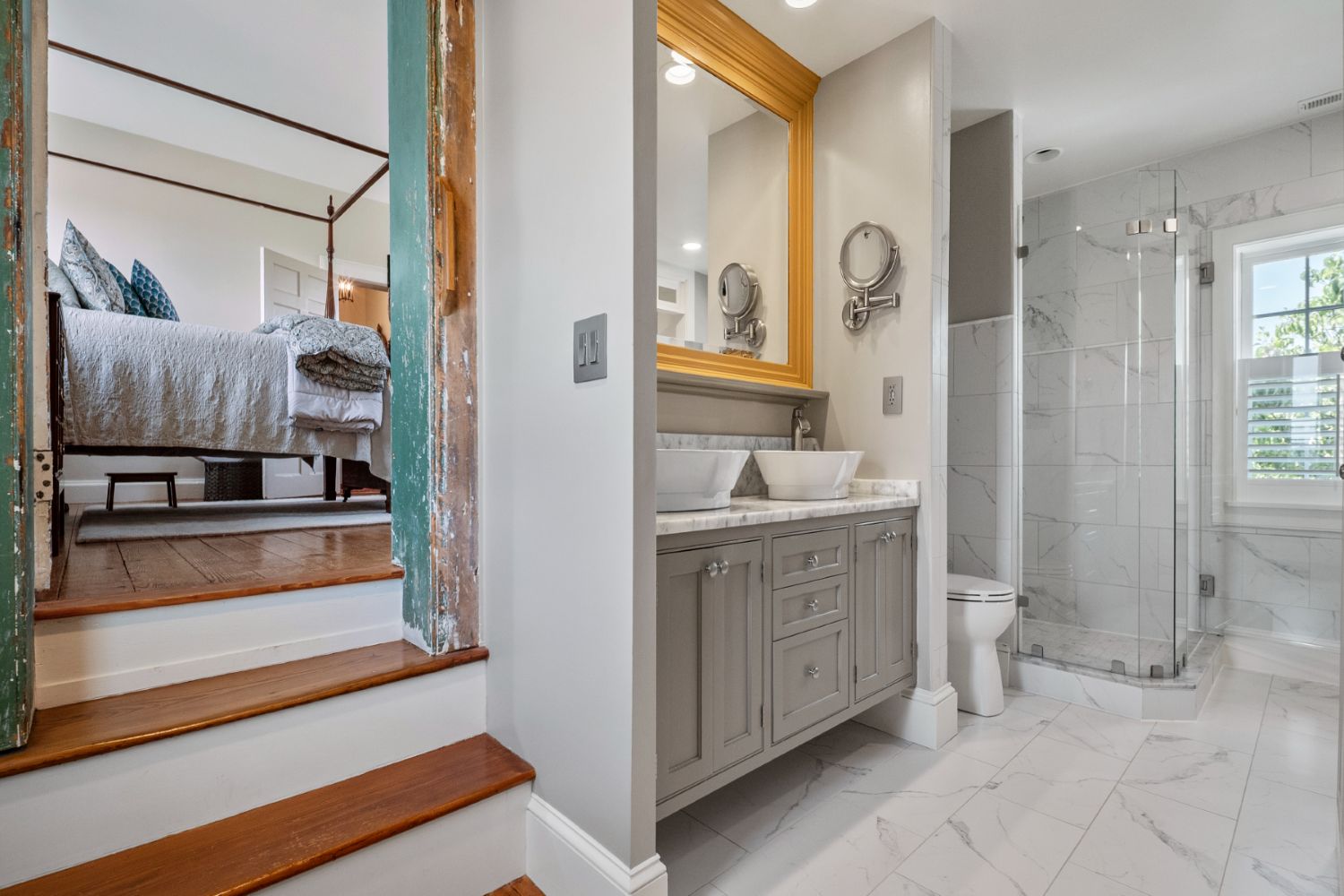
Transformed marble-finished spaces bring modern luxury to the heart of a historic wing.
It is difficult to realize that the elegant Primary Bathroom was once a storage room with crumbling lath and plaster walls, an old window with a plywood piece for a window treatment, and wood floors painted brown! Now the space is transformed with marble flooring and a Brazilian marble top for the dual lavatory’s floating cabinet with porcelain vessels. The glass walled shower and the one-piece eco-flush toilet are finishing touches. The Dressing Room with custom cabinetry completes the ensuite.

Exposed beams and sunlight filtered through square gable windows inspire quiet productivity.
The office is located at a quiet corner of the house and it its ceiling was removed to expose the rafters and the two square windows on either side of the chimney. The windows add additional sunlight to the room and the white walls accentuate the stained beams. The side gable wall infilled with bespoke millwork beckons one to select a book and relax in one of the chairs. When one is not working, the table and chair are positioned so one can take a break to look over a computer at the view of the landscape through the window.

Geometric rafters and whitewashed walls create a versatile attic, steeped in architectural intrigue.
Another set of stairs leads from the second-floor office to a finished attic, with sunlight from the windows and doors leading to storage areas under the eaves. I admired how the exposed stained rafters, ceiling joists and railing stand out against the white walls and ceiling to accentuate the office’s spatial geometry. This bonus room has myriad uses-second office, playroom, teen hang-out, extra sleeping space, etc.
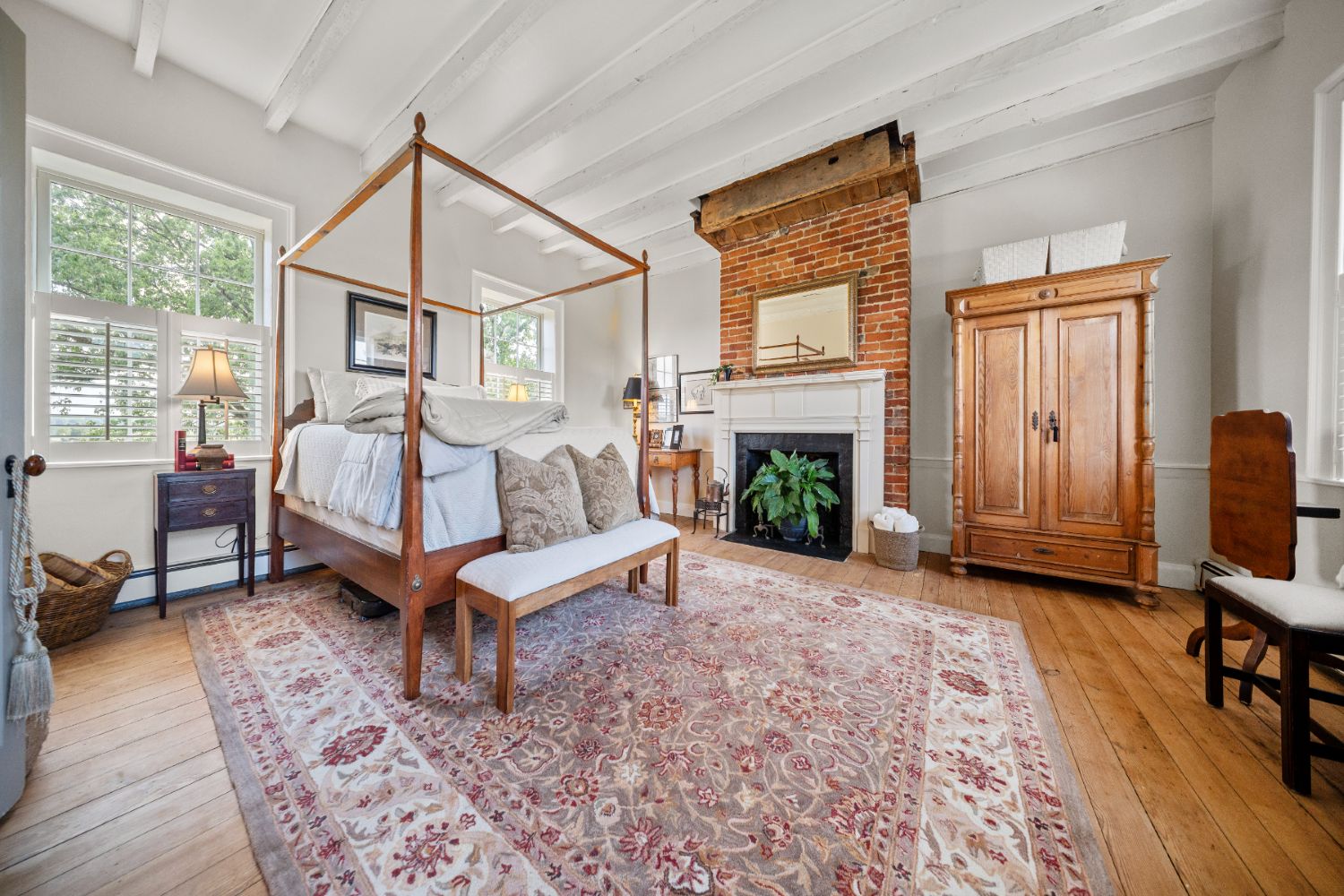
Preserved joists and weathered wood detail the restoration history of this elegant guest space.
I would be quite content to be a guest in this elegant bedroom opposite the stair hall and the primary bedroom. The four-poster bed, fireplace, armoire and the writing table would please any guest. The fireplace’s exposed wood framing illustrate a fire that occurred long ago from an old chimney fire and shows the sister joist techniques that were used to repair the damage. The fireplace surround is a simplified reconstruction.
The interior architecture of the bedroom is left “as-is”, to better study the original construction techniques. Old drywall partially obscures the chair rail, and the walls need to be replastered and the partial paint removal from the door offers clues as to its past colors. The beams are exposed in this room but they would have originally been covered by a ceiling.
Between the Primary Bedroom and the Guest Bedroom is a bath created by the space that was originally a large open landing off the stairs with a window for cross ventilation. The room’s size now easily accommodates a full bath.
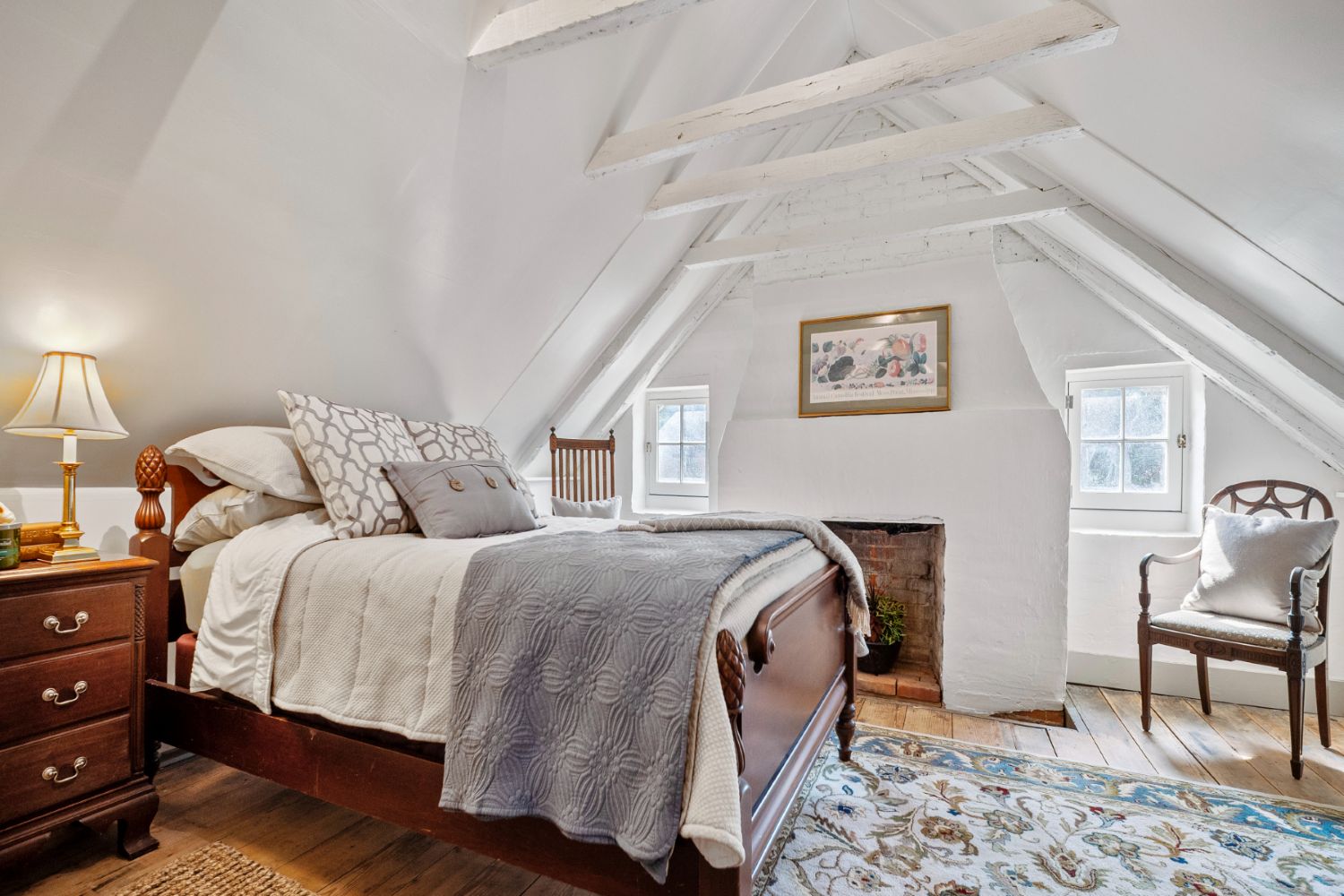
Earth-toned finishes frame serene vistas and the warm embrace of exposed beams.
My fave spaces in houses are always the charming spaces that are tucked under the roof’s framing. Here, the white enclosure of the walls, exposed collar beams and the chimney create a soothing space for sleep. The fireplace indicates this room was used all year, perhaps by the family’s children, servants, or enslaved people. The windows that flank the chimney offer bird’s eye views of the landscape three floors below. I lingered in this room because I especially liked the earth tones of this room’s interior design.
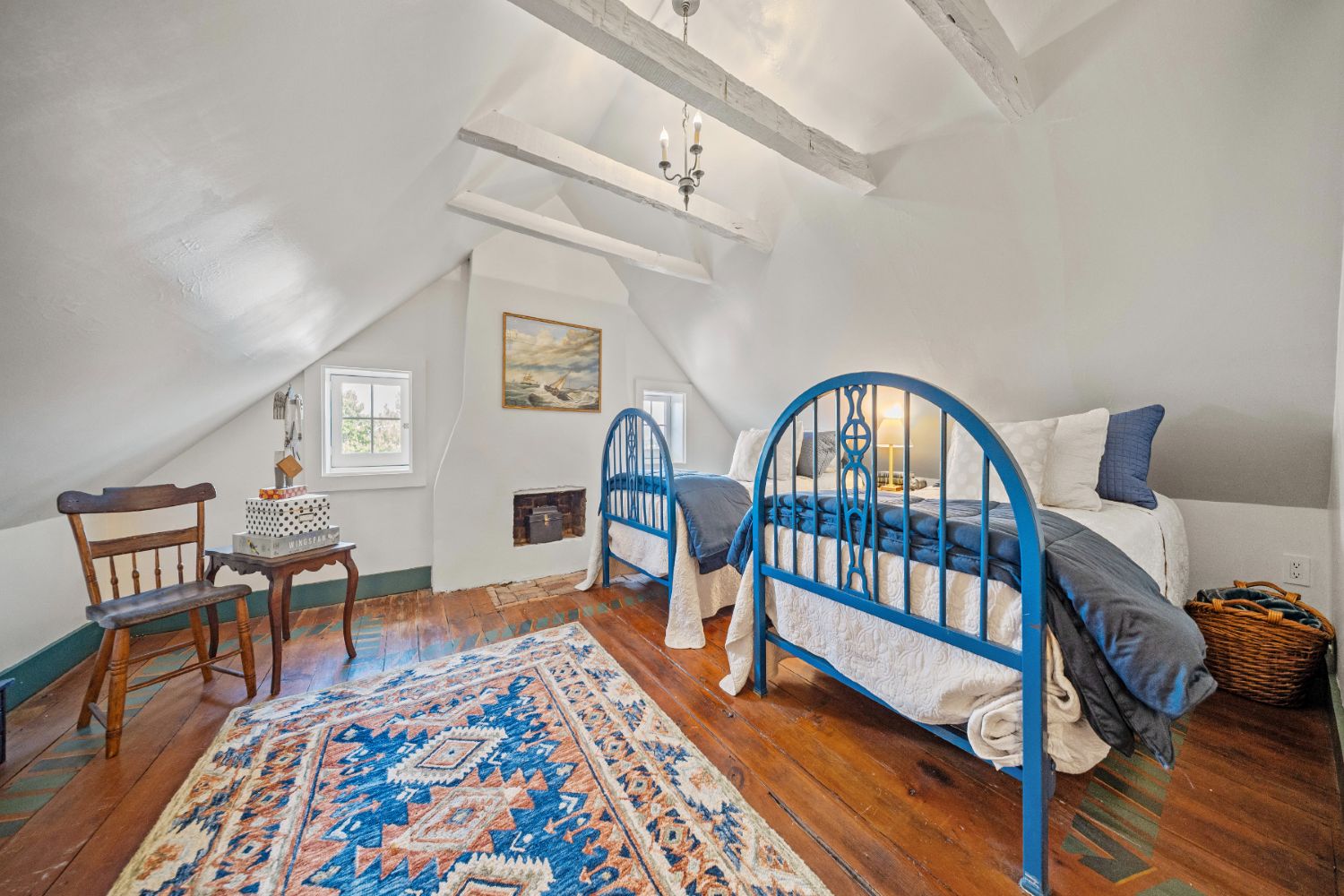
Playful geometry and bright accents make this charming twin bedroom a delightful retreat.
At the opposite end of the third floor is this delightful bedroom with colorful twin beds and the same spatial geometry as the other guest bedroom. The small windows on either side of the fireplace are called “lie on your stomach” windows since their sills are at the same height off the floor as the top of the beds are. The white walls and ceiling reflect the light and the blue accents of the baseboards, the frames of the twin beds and the blue in the rug create a fun and relaxing room for children of all ages.
The Owners’ philosophy of their stewardship of this remarkable property has been to preserve the house wherever possible as a learning lab of architectural history; while simultaneously adapting is use to accommodate a growing family over time. They thoughtfully left some small areas of walls throughout the house to expose the original techniques of its construction. They also obtained matching grants to become a host site for the University of Delaware’s Office of Archaeology and Historic Preservation. The cellar’s dirt floor was excavated 18” lower and recovered artifacts helped to document the life of an early 18th century house.
The house’s architectural characteristics and the shrinking inventory of historic sites also led the Owners to begin the process for “Mt. Pleasant” to be eligible to be listed in the National Register of Historic Places. I have no doubt that this unique house will soon be proudly displaying its plaque.
Realtors are sometimes accused of “puffing”, or exaggerating a property’s features, but as an architect, I can sincerely state that “Mt. Pleasant” far exceeds all of my selection criteria of site, architecture, interiors and landscape. The house’s gardens enhance the architecture and the exquisite interiors complement the interior architecture so harmoniously. My compliments to the Owners for preserving, restoring and renovating this important piece of Maryland’s architectural history. I envy the very lucky next steward of this unique property-Bravissimo and Bravissima!
For more information about this property, contact Laura Batchelor, with TTR Sotheby’s International Realty at 410-673-3344 (o), 571- 276-4375 (c), or [email protected]. For more pictures and pricing, visit sothebysrealty.com/ttrsir “Equal Housing Opportunity”.
Photography by Moses George Cohen, 202-688-8581, [email protected],
https://linktr.ee/delmarvaaerial360 ,www.DelmarvaAerial360.com
Aerial Photography by Delmarva Aerial Photography (Hardware Studios)
The author is indebted to the Owners for sharing their extensive research and detailed explanations of each room’s features, restoration and renovation.
Contributor Jennifer Martella has pursued dual careers in architecture and real estate since she moved to the Eastern Shore in 2004. She has reestablished her architectural practice for residential and commercial projects and is a real estate agent for Meredith Fine Properties. She especially enjoys using her architectural expertise to help buyers envision how they could modify a potential property. Her Italian heritage led her to Piazza Italian Market, where she hosts wine tastings every Friday and Saturday afternoons.
The Spy Newspapers may periodically employ the assistance of artificial intelligence (AI) to enhance the clarity and accuracy of our content.
The Spy Newspapers may periodically employ the assistance of artificial intelligence (AI) to enhance the clarity and accuracy of our content.
Miriam Schapiro was born in 1923 in Toronto, Canada, to Russian Jewish parents, but she was brought up in Brooklyn, New York. One of her grandfathers was a rabbi and the inventor of the first moveable eyeball for dolls. His invention was used in the manufacture of “Teddy Bears” in the United States. Her father was an artist and industrial designer; her mother was a homemaker. Both parents encouraged Miriam to make art, and by age six she was well on her way. She earned a BA at the State University of Iowa in 1945, an MA in 1946, and an MFA in printmaking in 1949.
During her college years, Shapiro met and married Paul Brach (1924-2007), also a Jew and an artist. During his service in the armed forces, Brach witnessed the horrors of the Theresienstadt ghetto and concentration camp in Czechoslovakia after it was liberated by the Russians in 1945. Schapiro’s Russian Jewish heritage certainly had an impact on her art. Brach received a position as a painting instructor at the University of Missouri. Miriam did not.
Schapiro and Brach moved in 1951 to New York City where they met the Abstract Expressionists, rising stars of the art world. She was not included in the group since women were not considered serious artists. She worked at the Parsons School of Design to earn money to pay for her son’s daycare in order to find time to paint. Her new paintings were large, like those of the men, and abstract with broad gestural brush strokes. The paintings were based on black and white photographs of the paintings of the Old Masters. Andre Emmerich selected one of her paintings for the inaugural exhibition at his new gallery in 1957.
Schapiro’s career began when she and Brach moved to California. She and Judy Chicago were employed in 1971 by the California Institute of Art in Valencia to establish the first Feminist Art Program. Woman House was an entire house given to the women. Each room was designed to reflect what women felt they needed to be and to do there. An entire book records the rooms and events that happened there. The results were outstanding. Schapiro’s work was developing in a new direction. She wrote in 1974, “I began to see myself as another kind of artist, as a woman artist, very much connected to those women who had made quilts, who had made samplers, who had done all of that women’s work throughout civilization, who are not honored, but whom I honor, and I honor them by continuing their tradition. The difference is that I don’t work with sewing; I’m a painter and I work on canvas, and I work in their tradition.”
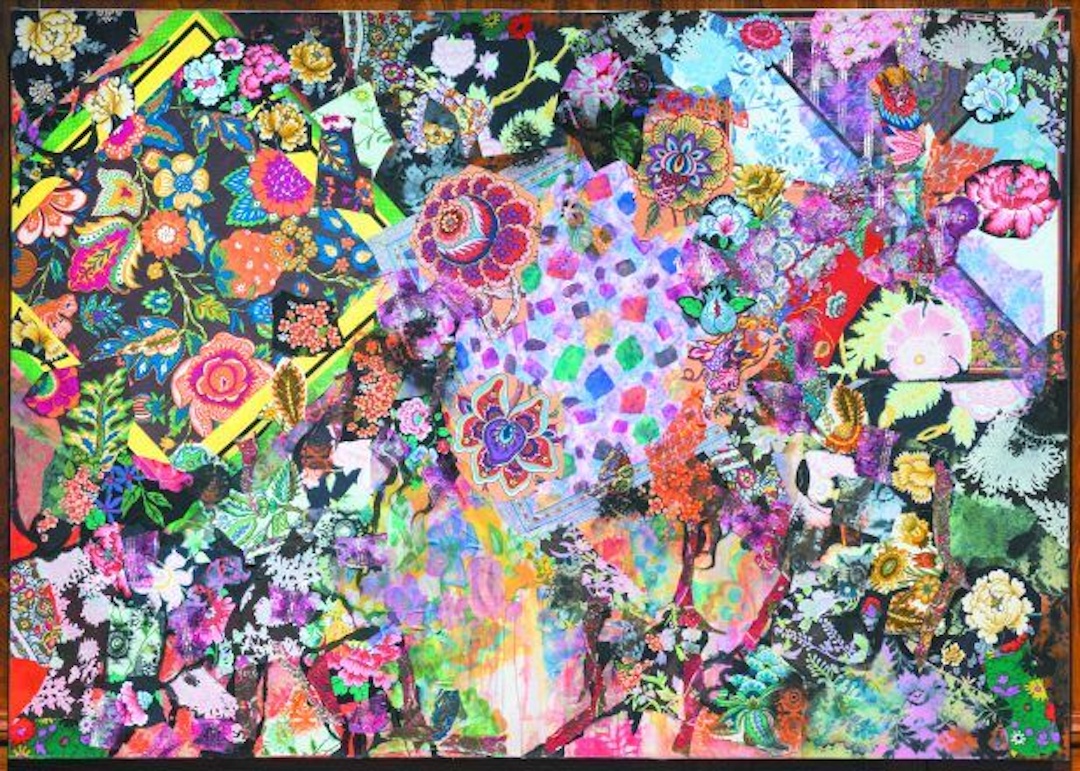
“The Beauty of Summer” (1973-74)
Shapiro began to study the role of women in art over time. She created mixed media art with paint and fabric, quilting, embroidery, applique, lace, ribbons, photographs, even the color pink. The works would have in her words a “woman-like context” that “celebrates a private and public event.” “The Beauty of Summer” (1973-74) is an early collage that celebrates Summer. Flowers abound, and the garden is full, overflowing with joy. It is feminist and unique, and it is engaging.
She was a major force in the Women’s Movement along with Betty Friedan, Bella Abzug, Gloria Steinem, and others. The National Organization of Women (NOW) was created, and the College Art Associations authorized the Women’s Caucus for Art (WCA), both in 1972.
She challenged the existing male dominated concept of high art and low art by creating what she called Pattern and Decorative Arts. She called the works femmage, inspired by the “art out of women’s lives” and intended to validate “the traditional activities of women.”

“Anonymous was a Woman” (1976)
Schapiro began with collages that paid tribute to such women as Impressionists Mary Cassatt and Berthe Morisot. She began her first Collaborative Series, working with nine women who were studio art graduates of the University of Oregon. The group was a reflection of the traditional collaboration among women to make quilts and lace. Each “Anonymous was a Woman” (1976) (30”x22”) (series of nine) was begun with an etched print of a hand-made doily.
She was invited to lecture in several states, and she collected samples of items from women who attended. She and fellow artist Melissa Meyer wrote and published “Waste Not Want Not: An Inquiry into What Women Saved and Assembled” (1977-78) that listed assemblage, decoupage, photomontage, “traditional women’s techniques–sewing, piercing, hooking, cutting, appliqueing, cooking and the like….”

“Barcelona Fan” (1979)
“Barcelona Fan” (1979) (72’’x12’) was inspired by the traditional hand-held fan. Schapiro said the fan “reveal[s] the unfolding of woman’s consciousness,” serving as “an appropriate symbol for all my feelings and experiences about the women’s movement. That’s a very ambitious notion: to choose something considered trivial in the culture and make it into a heroic form.” At 12 feet across, the piece embraced the practice of men making large works.
Fans have found their uses over time in many cultures. Women in the 19th Century used their fans to engage in discreet communication. The fan is an important element in flamenco dancing. Dancing was one of Schapiro’s passions. Areas of paint, fabric, and lace create a colorful and bold pattern divided into 24 radial sections, the whole divided into five semicircles.

“Barcelona Fan” (detail)
This detail of the outer semicircle provides a closer view of one of Schapiro’s iconic images.

Schapiro in her studio, ”Black Bolero Fan” (1980) behind her, and ”Azerbaijani Fan” in front
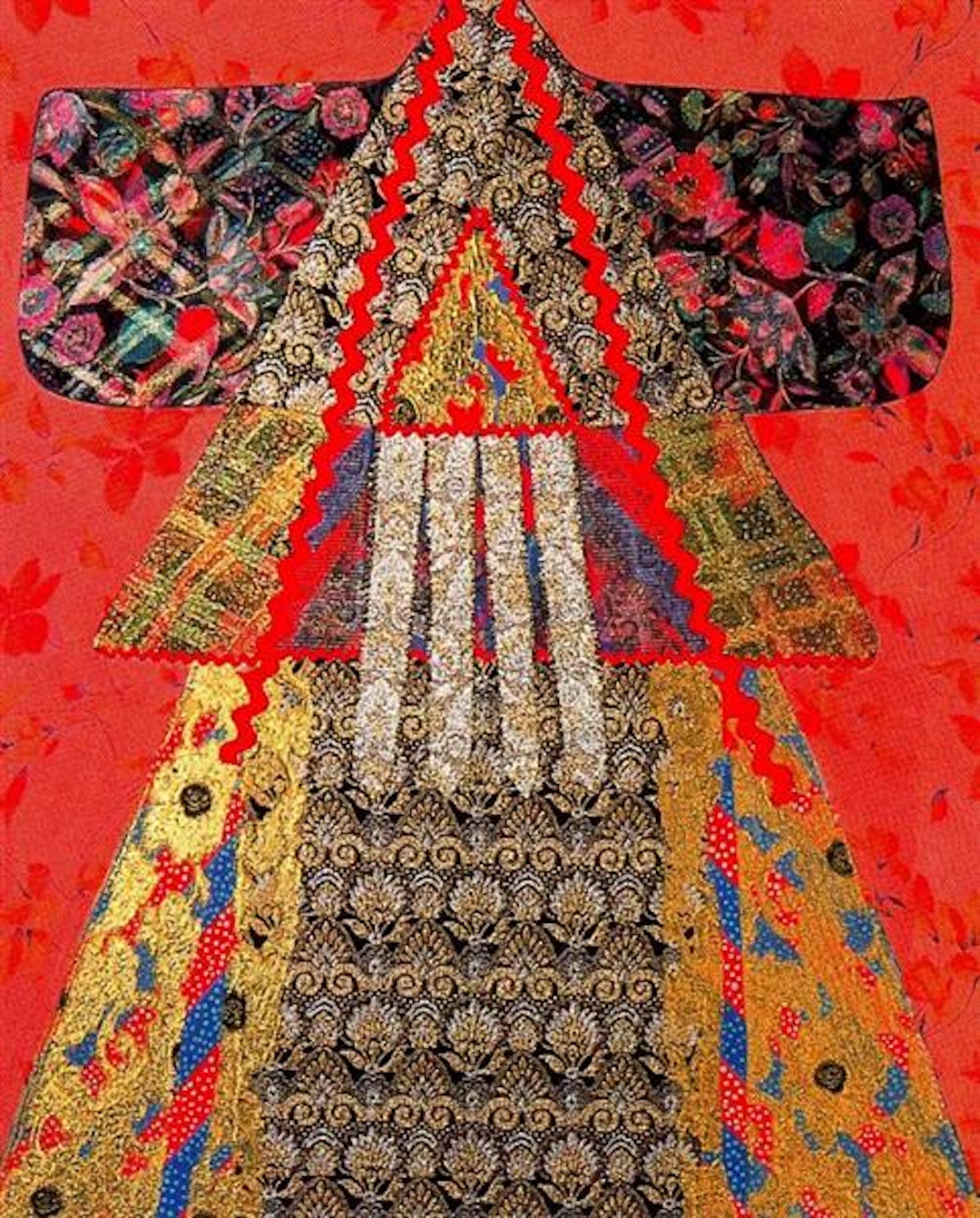
‘Golden Robe” (1979)
The fabrics and layered construction of Japanese kimonos fascinated Schapiro. “Lady Genji’s Maze” (1972) (not shown) was followed by “Anatomy of a Kimono” (1976) (52 feet long) (not shown) was followed by the Robes Series. “Golden Robe” (1979) is an example of the larger than life-sized collage of rich fabrics and distinct parts of a Japanese kimono. Schapiro’s kimono, fan, house, and heart-shaped canvases are among her iconic images.

“Four Matriarchs” (1983)
“Four Matriarchs” (1983) (80’’x30’’each) (acrylic) were designed for the Temple Shalom Community in Chicago. They represent the four Jewish heroines Sarah, Rebecca, Rachel, and Leah. The paintings were then made into stained glass windows for the Temple. Schapiro’s renewed interest in her Jewish roots also resulted in several works depicting Anne Frank and in particular Frida Kahlo, who referred to herself as Jewish, and with whom Schapiro identified as an artist. Each of Schapiro’s painted Matriarchs wears a brightly colored patterned garment and a unique hair style. They are linked together by semi-circle arm patterns. This design was commissioned to be made into stained glass.

Viewed in place, the Temple Shalom designs are brilliant. Schapiro’s strong interest in the patterns and colors of ancient Russian clothing come into play here. She has added to her depictions of women artists the Russian Avant Gard artists Popova, Goncharova, and Rozanova, and the French artist Sonia Delaunay. These women brought art into the modern age in the early 20th Century, alongside their male counterparts.
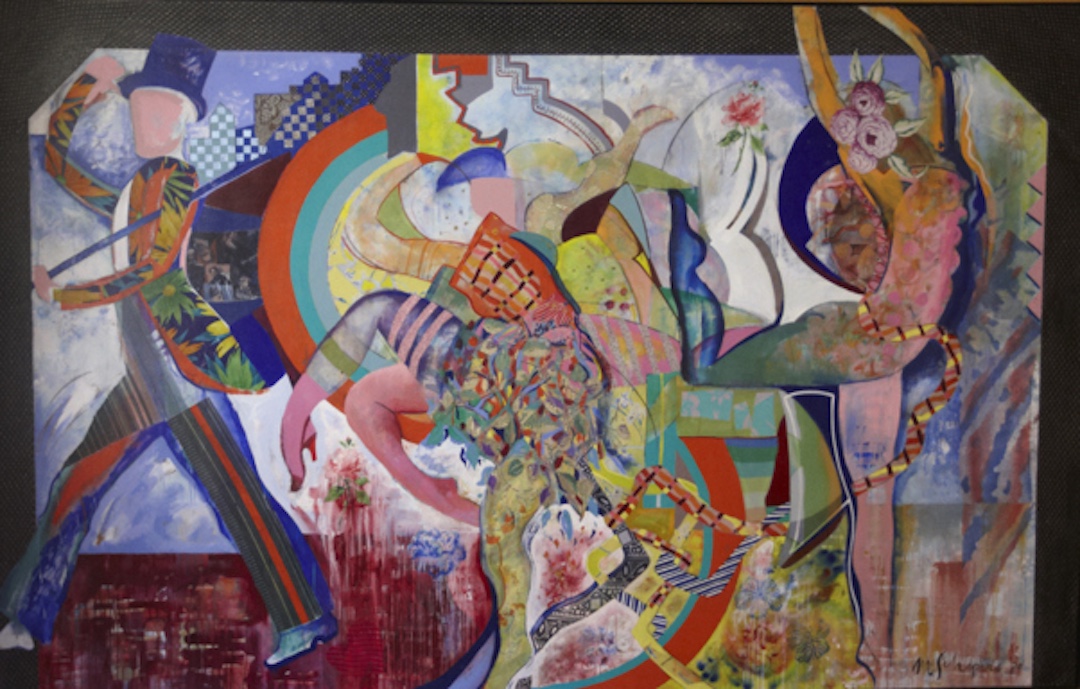
“I’m Dancin’ as Fast as I Can’’ (1984)
“I’m Dancin’ as Fast as I Can’’ (1984) is one of Schapiro’s autobiographical pieces. She worked hard to balance her various roles as a woman, mother, artist, historian of women in the arts, breadwinner, and challenger of male authority. When she was young, she took dance lessons, and her designs and patterns do have a sense of rhythm. She is the whirling dancer at the center of the composition, and the ballet dancer at the right side of the painting. Yet, a striding male figure leads the viewer out of the composition, leaving the women behind. He holds a cane and tips his hat. Miniature portraits of Goya and Van Gogh are included along with signatures of Rembrandt and Picasso on the blue back of his coat. The red, black, and yellow umbilical cord that links the ballet dancer to the whirling female is a personal statement
Schapiro danced as fast and as hard as she could, and among the many exhibitions and honors she received in her lifetime were four honorary doctorates and a Lifetime Achievement Award (2002) from the Women’s Caucus for Art.
“I talk about women’s traditional art, the art of women who decorated pots or did the weaving—the great Navajo weaving—the eye-dazzlers of the southwest. Most of the decorative art has been done by women throughout time and civilization. What happened long ago in art criticism was that a distinction was made between high art or fine art and low art or craft/decorative art. And all that craft/decorative/low art which needs a superb sense of color and design has been done primarily by women. So the patriarchal fix in criticism has always made that sexist distinction. What women did in the seventies was to reinvent pattern and decoration as an integral part of high art.” (Miriam Shapiro)
Beverly Hall Smith was a professor of art history for 40 years. Since retiring to Chestertown with her husband Kurt in 2014, she has taught art history classes at WC-ALL and the Institute of Adult Learning, Centreville. An artist, she sometimes exhibits work at River Arts. She also paints sets for the Garfield Theater in Chestertown.
The Spy Newspapers may periodically employ the assistance of artificial intelligence (AI) to enhance the clarity and accuracy of our content.
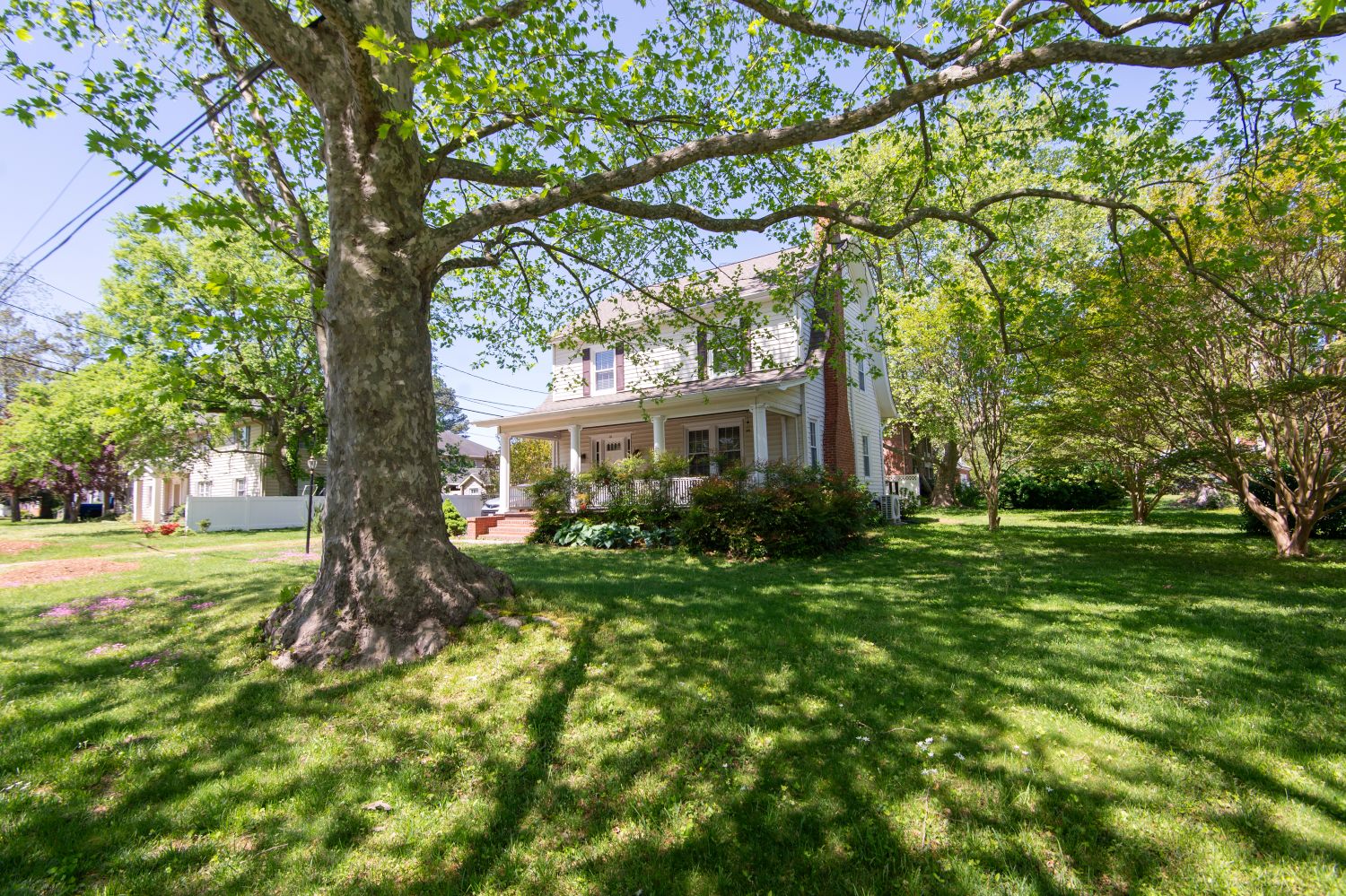
Mature landscaping frames the Dutch Colonial gambrel roof and flared eaves
Since my Spy beat is now four counties, I have enjoyed getting acquainted with Cambridge’s streetscapes around Hambrooks Bay with their mix of architectural styles. This charming house caught my eye since I am especially fond of the Dutch Colonial Style. The house was built in the 1930’s, the heyday of cottage design in the US and its gambrel roof with flared eaves and shed dormers are distinctive design elements of this style that maximizes the floor area at the second floor.
On the day of my visit, I admired the house’s picturesque setting amidst mature landscaping and the front yard’s massive sycamore tree whose wide canopy casts deep shadows onto the lawn. The wide street provides parking on both sides, and its location is only two blocks to the Gerry Boyle Park at Great Marsh along Hambrooks Bay and the Choptank River.
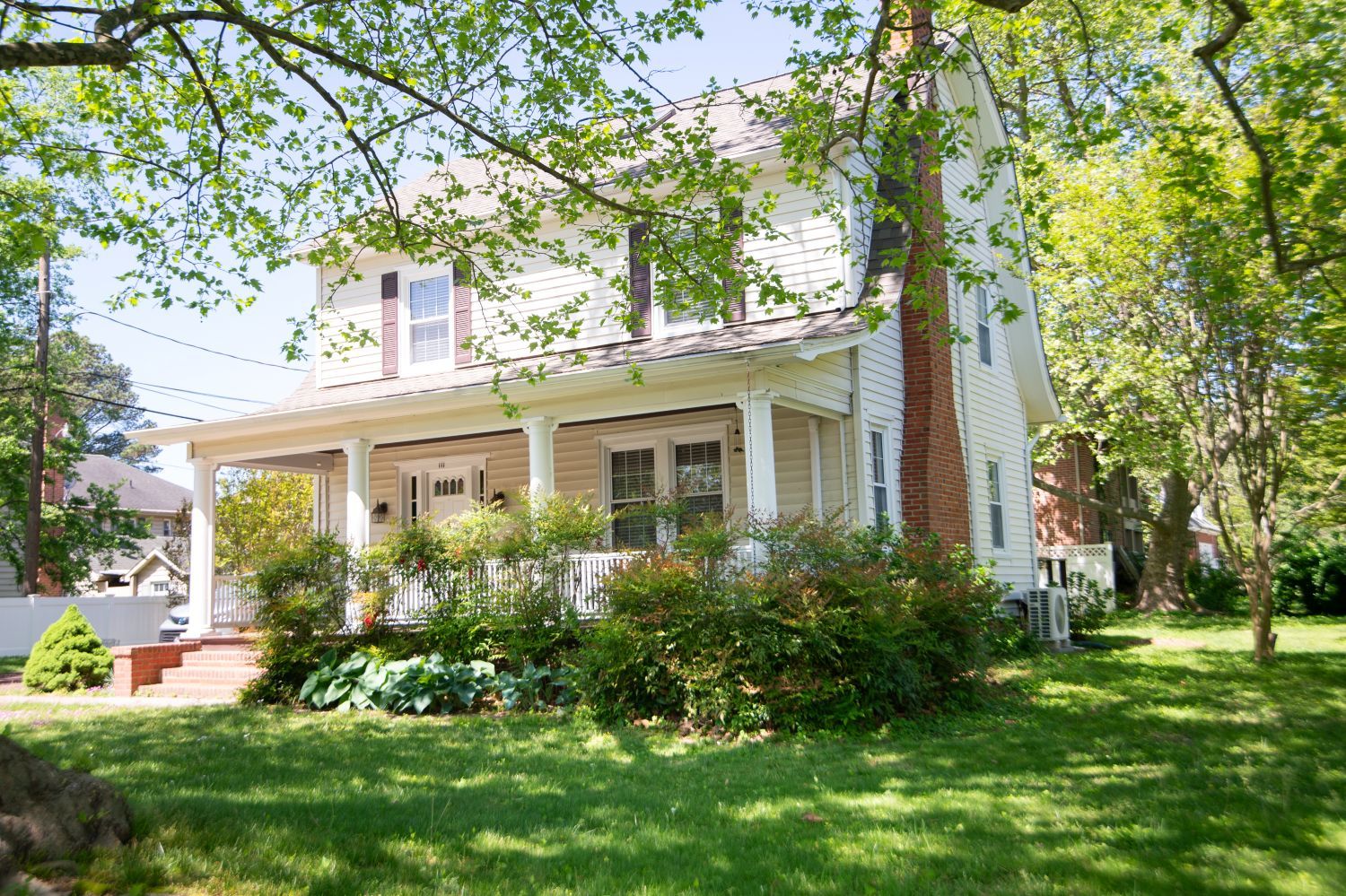
Brick foundation contrasts beautifully with layered siding and shutters.
As I walked around the house, I admired how the house’s exterior palette of exposed brick foundation, light lap siding and darker shutters stood out against the landscape. Plantings of giant hostas along the exposed brick foundation in front of the higher nandina wrap around the corner to meet the two large hydrangeas that flank the brick chimney. As inviting as the front porch was, I continued my tour of the grounds.
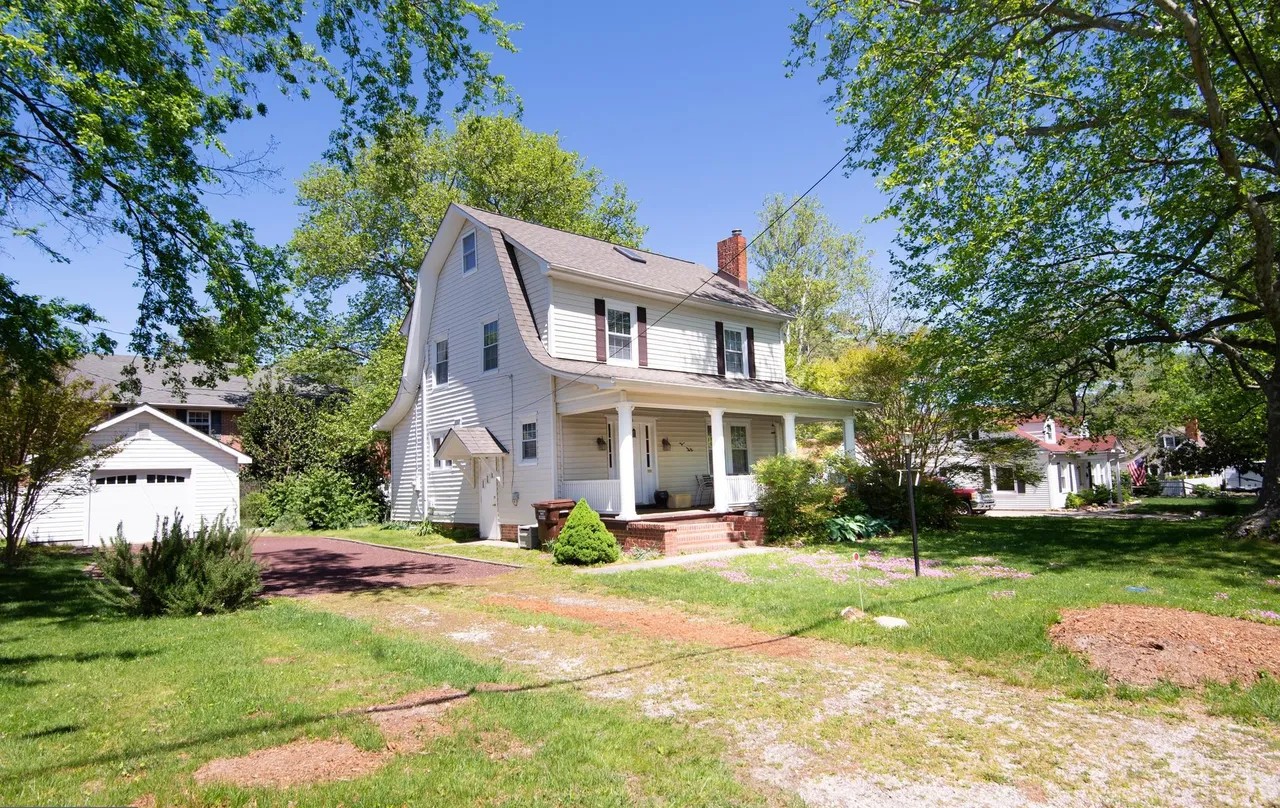
Gambrel eaves blend effortlessly with dormer and porch roof lines.
The house’s full shed dormer and the gambrel eaves that blend into the front porch’s shed roof enliven both the side elevation facing the driveway and the garage and give the house its charm. The house’s side door at grade level was common in the era of cottage design since it led to a half flight of steps up to the first floor kitchen and a half flight down to a basement. The row of crape myrtle at the front side of the garage will soon add its color to the landscape.
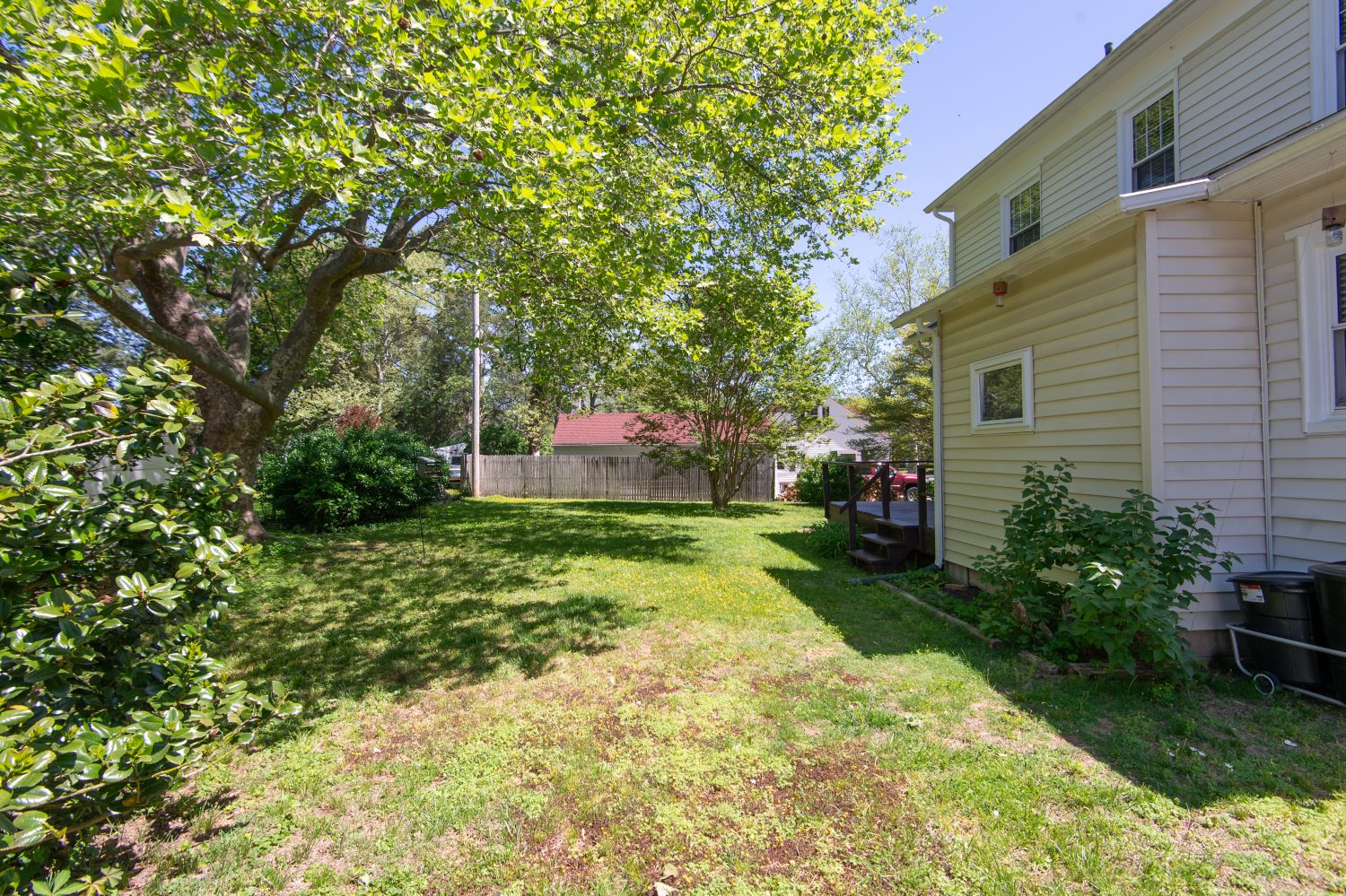
Privacy enhanced by fencing and tulip poplar canopy in the rear yard.
From the garage, the massive tulip poplar shades most of the rear yard and the combination of fencing and mature landscaping gives the property privacy. At the rear of the house, a slight extension from the original wall contains a side by side W/D and a full bath, which makes after gardening clean-up easy.

Deck provides seamless connection to landscaping and outdoor relaxation.
The deck off the laundry area is a delightful outdoor room for relaxing or dining al-fresco. The full shed dormer provides bird’s eye views of the verdant landscape from the second floor’s bath and two of the three bedrooms.

Front porch depth enhances functionality while complementing earthy tones.
After my tour of the grounds, I walked up the wide brick steps that lead to the house’s other outdoor room, the front porch that stretches across the length of the house. The brown wood slat ceiling continues the earth tones of the exterior materials. One of my architectural pet peeves is a porch that is too shallow to allow passing a person seated in a chair. This porch gets high marks for its depth that allows ample space for relaxing on the chairs with family and friends.
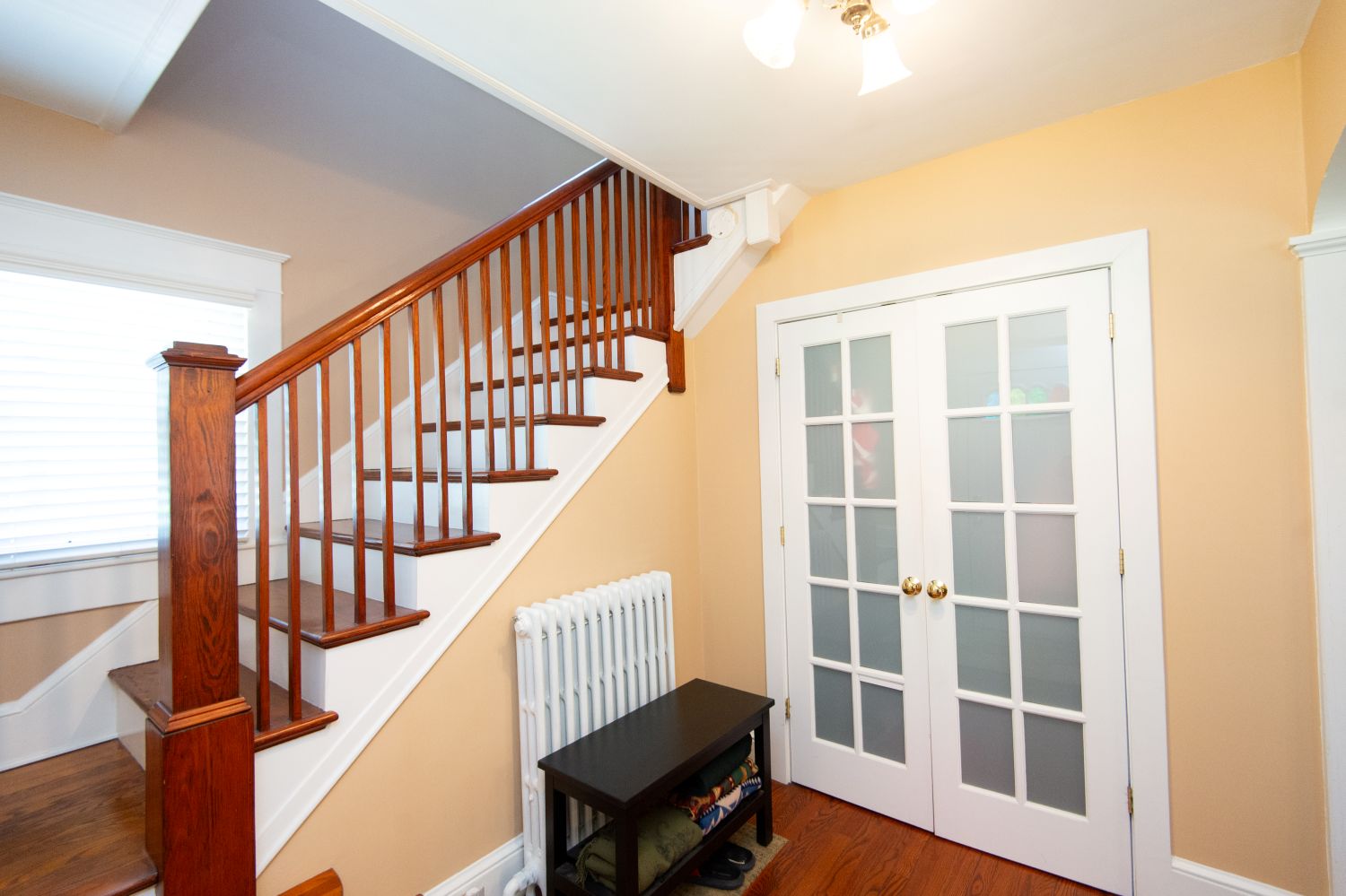
Frosted glass sidelights pair with woodwork and radiant natural light.
While I admired the front door’s half sidelights and half paneled surround, the Owners came out to welcome me into the spacious foyer with direct sunlight from the large window above the stairs. I wondered if the pair of French doors led to the adjacent room but they actually open into a large closet for family coats. The doors’ frosted glass semi-transparency is a more imaginative solution than wood doors. The bench in front of the radiator has shelves for storing wellies and boots. The wall color, crisp white woodwork and the beautiful wood floors introduces the interior design scheme found throughout the house.

Elliptical arch adds architectural elegance to the living room entryway.
This house’s design incorporates many period details like the elliptical arch that springs from pilasters and trim at each side to gracefully frame the view of the living room from the foyer. Painting the underside of the arch white instead of the wall color accentuated the opening into the living room. The vista through the living room ends at a fireplace with a pellet stove insert, flanked by single windows.
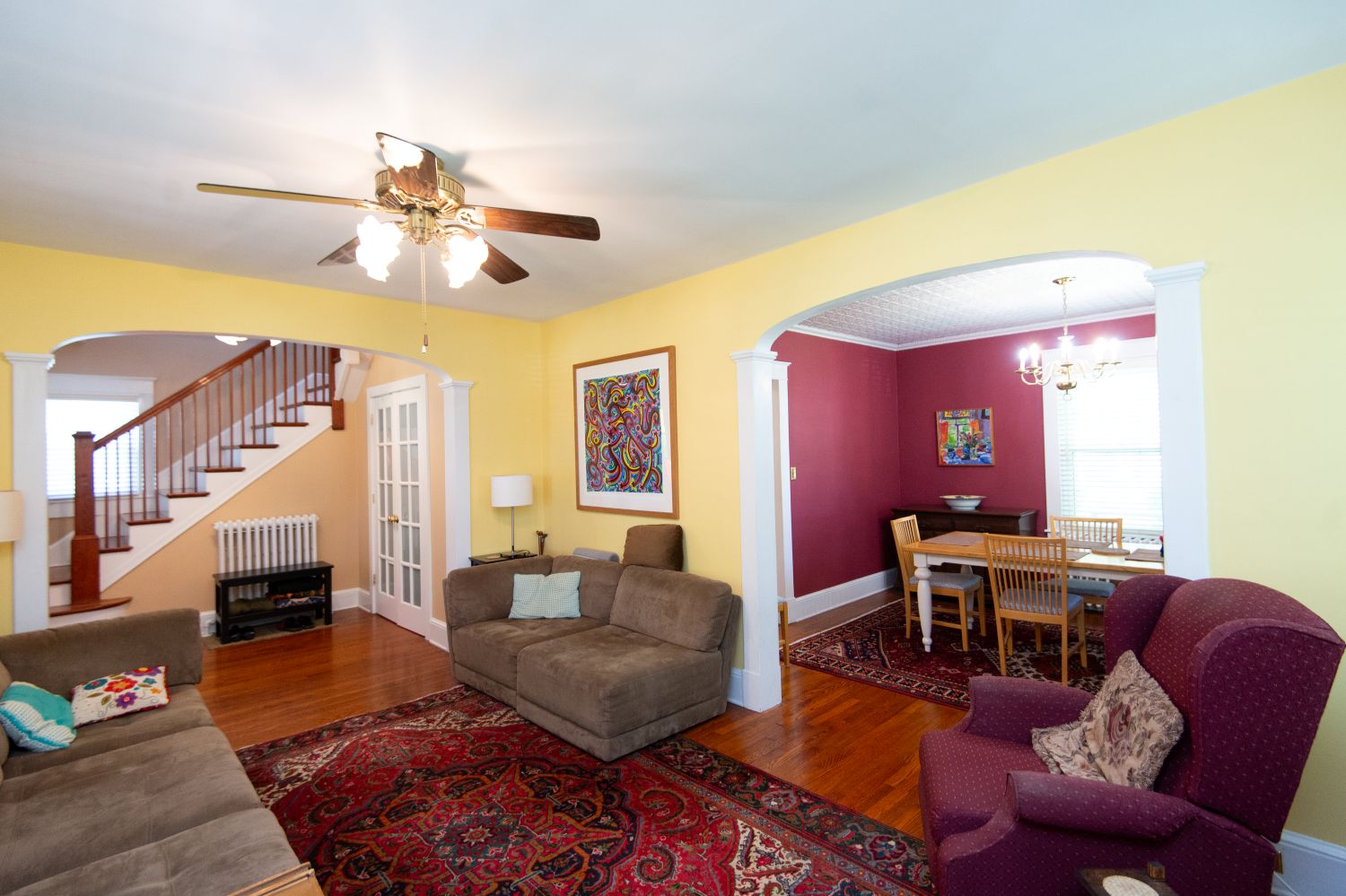
Dual arches frame dynamic sightlines connecting living spaces.
I love dual vistas like this one from the living room’s fireplace to the foyer beyond and through another elliptical arch that frames the dining room. I also appreciated the Owners’ use of bold colors as backdrops to their furnishings, since the living room has ample sunlight from the single side wall windows and the double front window that keep the room bright.

Pressed tin ceiling adds vintage charm atop bold red walls.
The corner dining room has a single window on each exterior wall for views of the landscape. I loved the original pressed tin ceiling that floats above the bright red walls. The room’s size could easily accommodate six chairs around the table for family celebrations or dinner parties.

Granite counters meet vintage hardware in this eclectic culinary space.
An open doorway leads from the dining room to the kitchen. The upper wall of cabinets has an extra row for infrequently used items. Another doorway leads to the extension containing the adjacent laundry and full bath. The mix of beautiful wood floors, vintage wrought iron hardware, period pendant light fixture and granite countertops create an eclectic look.

Compact laundry layout opens directly to the deck and rear yard.
I envy any laundry that is not a stack W/D in an alcove like mine! This efficient space has everything one needs with the shelf and the drying rack tucked against the wall but adding a countertop would be very easy. The side door opens into a full bath and an exterior door leads to the deck overlooking the rear yard.
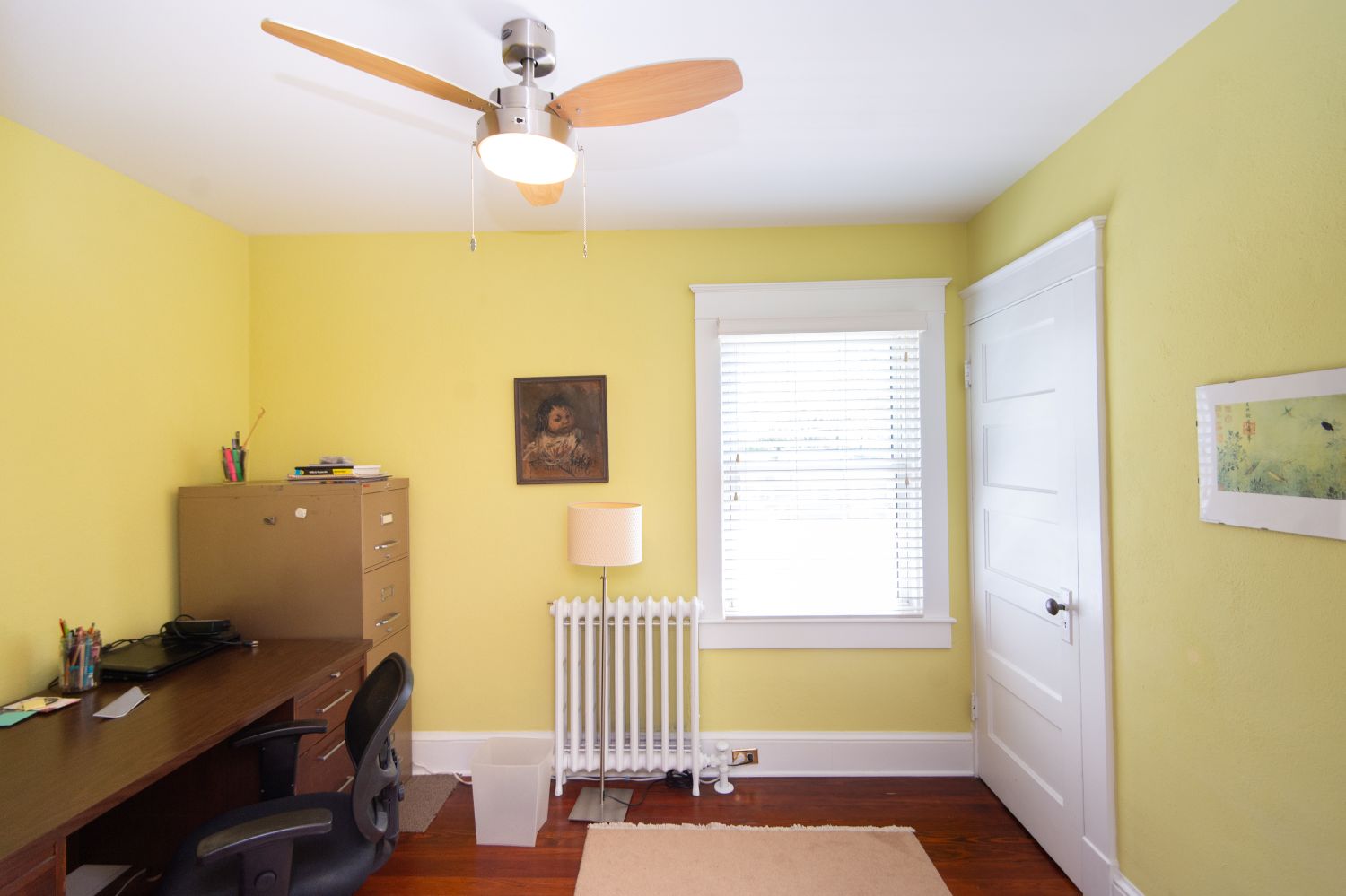
Butter yellow walls highlight original moldings and five-panel doors.
The stairs to the second floor lead to a short hall past two guest bedrooms. This front bedroom’s butter yellow walls highlight the white trim of the moldings and the vintage five panel door. The period five-panel door leads to stairs to the third floor.

Landscape views harmonize with blue accents and quilt design details.
Opposite the other guest bedroom is another guest bedroom with two windows that offer panoramic views of the landscape below. I admired how the diagonal pattern of the bed’s quilt is outlined in blue to complement the walls.

Recessed shelves and cabinetry optimize storage without crowding space.
Past the two guest bedrooms, the hall wall is angled at the door to the hall bath. This clever detail creates a linen closet that backs up to the blue bedroom’s closet. The hall bath’s white plumbing fixtures stand out against the light brown wall and the above the toilet is both a shelf for everyday toiletries. Both the cabinet above the toilet and the shelves recessed into the wall offer additional storage. The window overlooks the rear yard’s landscaping.
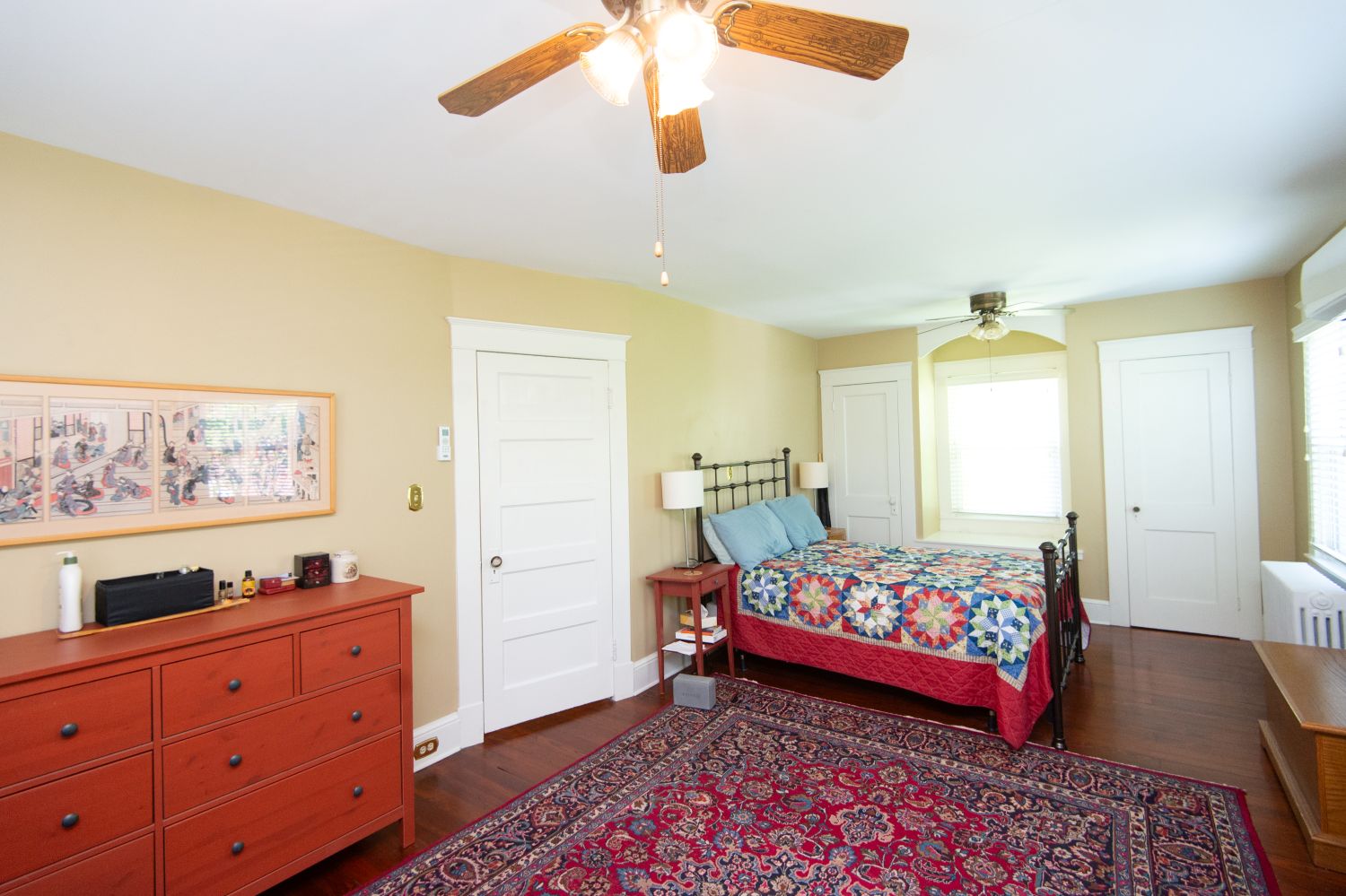
Double closets flank arched window seat overlooking mature trees.
The spacious primary bedroom at the end of the short hall spans the length of the house and the door divides the space into two areas. Between the two closets is another arched opening over a window with a seat below. Since the primary bedroom is next to the hall bath, it would be relatively easy to add a bath for the primary bedroom.

Expansive bonus room with knee-wall storage and sunny skylight.
The steps to the third floor bonus room open into a space that spans the width and length of the house, with access to storage behind the knee walls. Windows at each end and the skylight keep this space sunny for myriad uses-office, studio, hang-out space for kids or grandkids, etc. The space’s former use was as a rehearsal space for several local bands, including “Luke”, “Drawbridge” and the classic rock band “Transfuzion” – an Eastern Shore favorite.

Open parkland with panoramic views, sports facilities, and recreation.
The real bonus to this house’s location is its being only two blocks away from Gerry Boyle Park with its open spaces for touch football, tennis courts, County sports fields, playground equipment, a pavilion for large group picnics, boat launch, small beach, and fishing. The Park offers front row seats for watching the Eagleman/Iron Man happenings as well the APBA Power boat races and the 4th of July Fireworks.
This charming house is located just beyond the Historic West End District so there are no restrictions for modifications and the deck could be replaced with a family room addition. Great curb appeal from both its picturesque setting with mature landscaping that includes majestic trees for shade and also the Dutch Colonial architecture that maximizes the second floor rooms’ sizes; outdoor rooms of the large front porch and rear deck; compact floor plan; period details of graceful arched openings, moldings, beautiful wood floors and original five-panel interior doors; basement for storage and a third floor for myriad uses; one-car detached garage; all this and its location between the Dorchester YMCA and Gerry Boyle Park-hard to resist!
For more information about this property, contact Sharon Real Estate Associate Broker Sydney Cohee, GRI at 410-228-2525 (o), 410-476-7519 (c) or [email protected]. For more photographs and pricing, visit www.sharonre.com , “Equal Housing Opportunity.”
Photography by Bill Whaley, www.billwhaleyphotography.com ,(443) 477-1928
Contributor Jennifer Martella has pursued dual careers in architecture and real estate since she moved to the Eastern Shore in 2004. She has reestablished her architectural practice for residential and commercial projects and is a real estate agent for Meredith Fine Properties. She especially enjoys using her architectural expertise to help buyers envision how they could modify a potential property. Her Italian heritage led her to Piazza Italian Market, where she hosts wine tastings every Friday and Saturday afternoons.
The Spy Newspapers may periodically employ the assistance of artificial intelligence (AI) to enhance the clarity and accuracy of our content.
The Spy Newspapers may periodically employ the assistance of artificial intelligence (AI) to enhance the clarity and accuracy of our content.